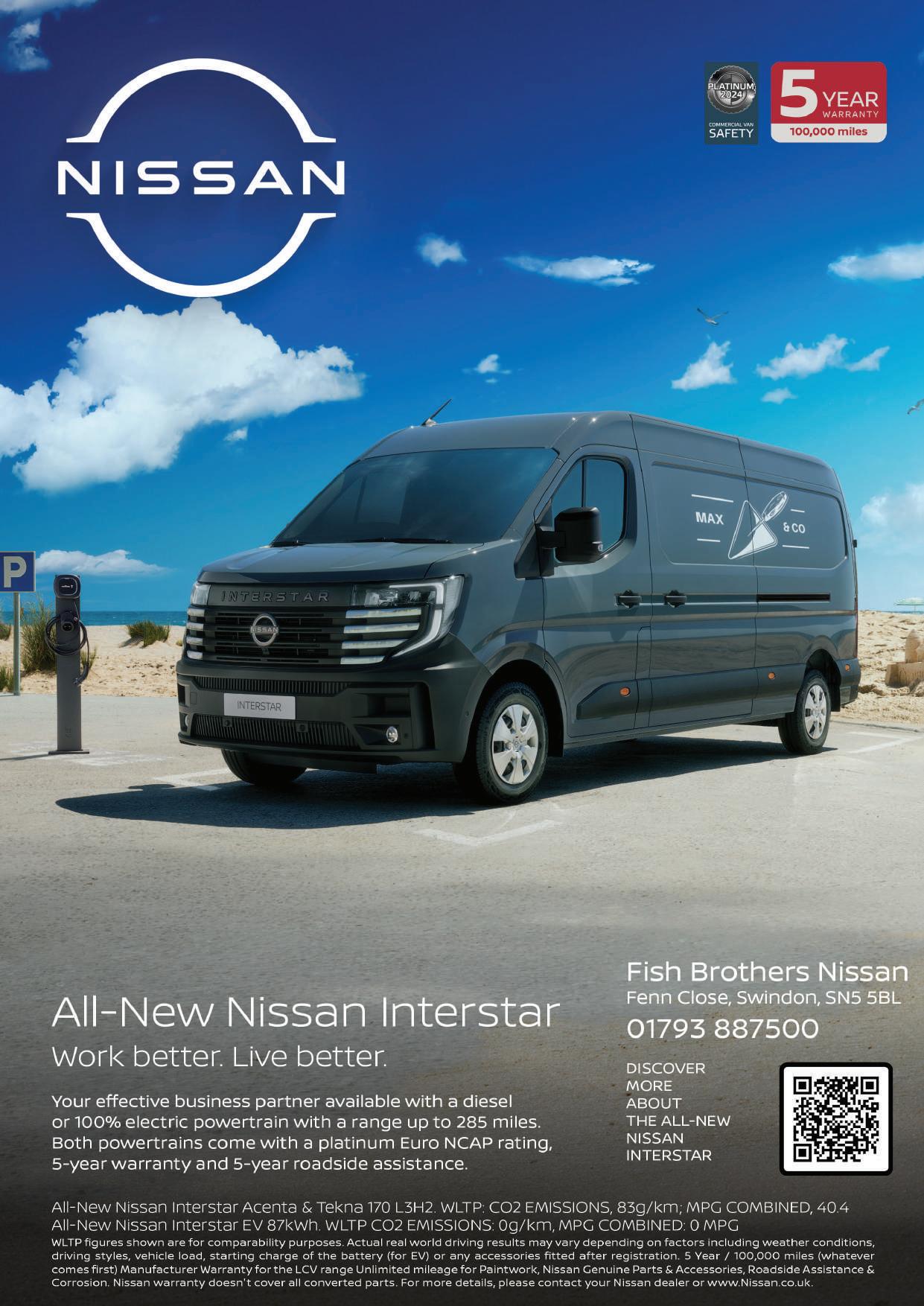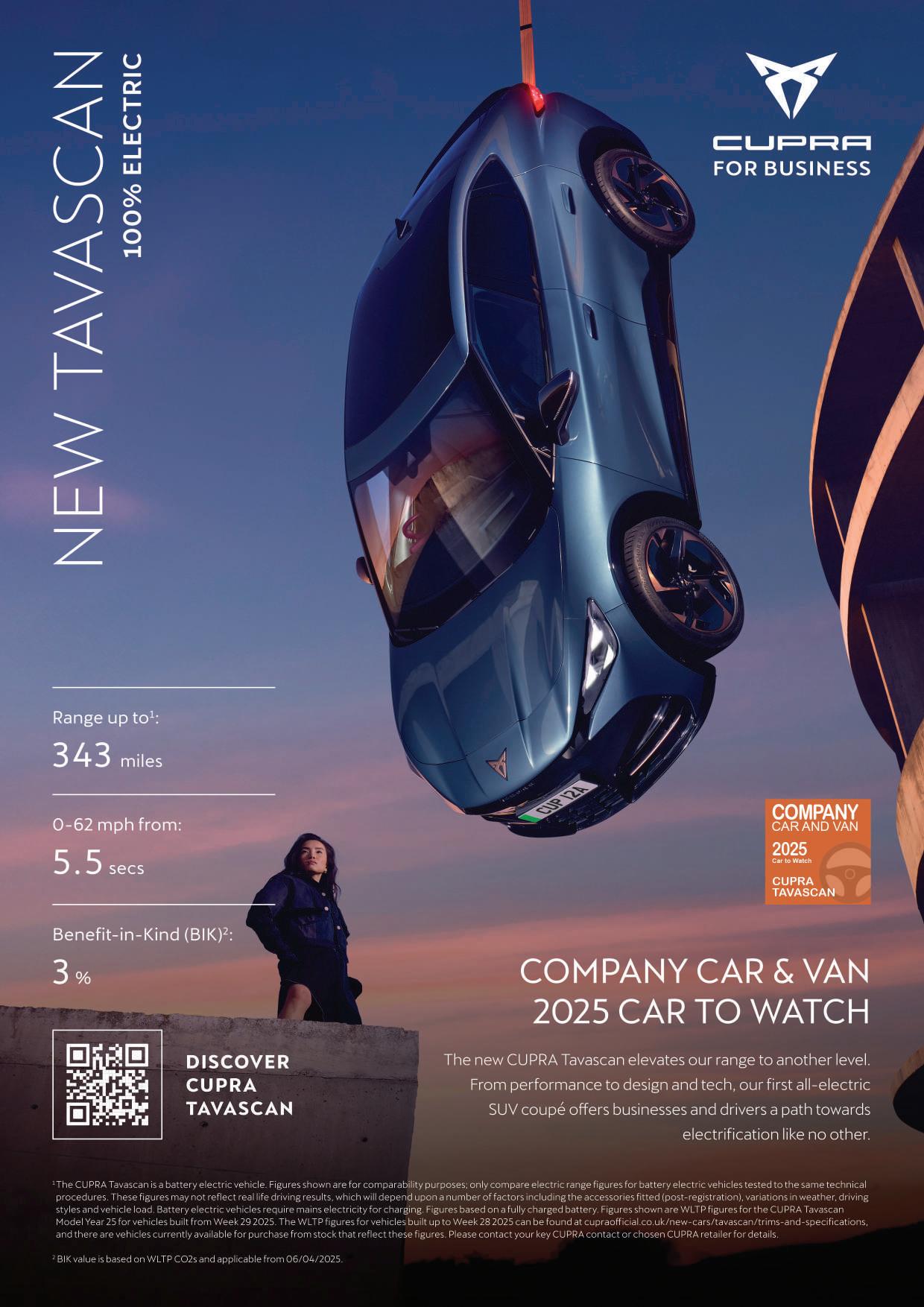
The motoring magazine for SME fleets







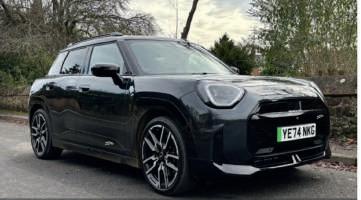














SUMMER has arrived and with it, holidays a’plenty. Whether you’re staycationing or heading abroad there’s plenty of interesting news in this issue of CC&V which you can read while you’re chilling at the beach or the pool.
Our cover star is the Cupra Tavascan, the brand’s second electric car and one that’s been well worth the wait. We spent a week in this striking SUV coupé and discovered there’s an awful lot to like.
Car road tests
Skoda has updated the Enyaq, its electric SUV, and it now comes with a cleaner interior and longer range. And if you’re looking for small car fun, Mini has just launched a John Cooper Works version of the Aceman, and it doesn’t disappoint.
Considering an electric SUV? Vauxhall’s Grandland Electric surprised us in a good way, offering an impressive driving range and plenty of other positives. Peugeot’s E-3008 is our reigning Car of the Year, and for good reason. It’s a stylish, practical electric SUV with a 400-mile range. Say no more
For those not quite ready for full-EV, our Plug-in Car of the Year, the MG HS, is well worth your time. And if you need a sevenseater PHEV that looks the part, why not take a look at the Mazda CX-80.
Chinese brand BYD is launching cars right,

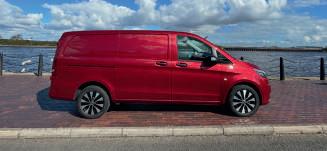
left and centre, and its latest, the DOLPHIN SURF, aims to electrify the small car sector. Also from China is OMODA whose latest model, the 9, offers premium motoring at a lower price point.
CV road tests
We’ve just returned from Amsterdam where we put the Volkswagen Transporter Electric through its paces. With a 200 mile + range and plenty of Volkswagen DNA it’s an electric van that’s ready to work for you.
Electric pick-up required? Currently there’s only one: the Maxus eTERRON 9, a chunky entrant from China. We took one for a spin around Liverpool and it certainly turns heads.
You can also read how we got on in the updated Isuzu D-Max V-Cross pick-up, and the addition of a larger battery on the MercedesBenz e-Vito in 2024 has made it far more competitive in the electric van sector.
Nissan’s new Interstar has hit the streets. With both diesel and electric drivetrains, there’s sure to be one of these large vans that’s right for you.
Finally, regulars Rolec update us on electric charging for fleets, Rivervale explains salary sacrifice and Vanaways’ incredible service continues to keep van customers happy.
Enjoy the holidays.
Andrew Walker, Publisher
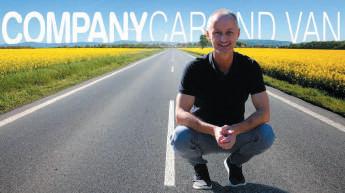
07734 264735 e: andrewmaxwalker@icloud.com w: www.companycarandvan.co.uk Follow us at twitter.com/andrewmaxwalker and www.linkedin.com/in/companycarandvan

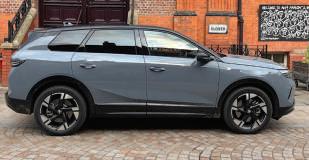



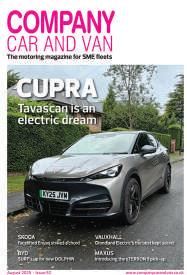
THE UK’s manufacturing leader with over six years of expertise in DC rapid and ultra-rapid charging, Rolec proudly launches its upgraded UltraCharge range, in a strategic partnership with EVbee. The collaboration brings together two forward-thinking companies with a shared mission: accelerate the rollout of EV infrastructure.
EVbee, a high-profile Dutch design and engineering company that’s renowned for its EV charging technology, has a strong presence across Europe and a commitment, shared by Rolec, to operational excellence and modular, intelligent solutions.
Now, as a combined force, Rolec and EVbee have announced four new additions to the UltraCharge range. The result is a more well-rounded, premium package, better supported, and more future proof.
Launched to serve a broader spectrum of commercial and public sector applications, offering wider power outputs, from 40kW to 1.6MW+, the UltraCharge range is available now. Without losing the most competitive DC range status, Rolec has upgraded the standard specifications, including improved LCD screens and advanced cable management solutions, a major advantage to Rolec’s offering.
Frankie Mellon, Managing Director at Rolec, said: “Both companies have a strong green tech synergy and a shared focus on DC expansion and agile design. A common drive for compact, modular, and user-friendly unit design, remote diagnostics, and adaptable mounting options, enables faster and more versatile deployment.
“Rolec actively seeks out innovative partners who are working closely with R&D, technology, people, and progress, and EVbee perfectly fits that vision.”
Rolec’s offering is now even more compelling, with an improved standard specification that delivers greater value without increasing costs. Installers will be pleased to know the new units offer a smaller footprint and easier installation, from initial configuration to continued maintenance and servicing, firmly cementing Rolec as a commercial charging powerhouse.
Packing a lot of juice into a smaller unit, the UltraCharge 40 is a compact, sophisticated, and low-investment DC charger delivering up to 40kW. Ideal for small businesses, workshops, and workplaces requiring rapid charging, it can be either wall or post mounted.
All of this makes it well suited as an option for fleet and public charging, while contactless payment options combine speedy charging with seamless payment.
A familiar name in their scalable DC range,

The UltraCharge 180 is an intelligent, modular and scalable DC ultra-rapid charging solution, futureproof and cost-effective for fleet and public infrastructure deployment.
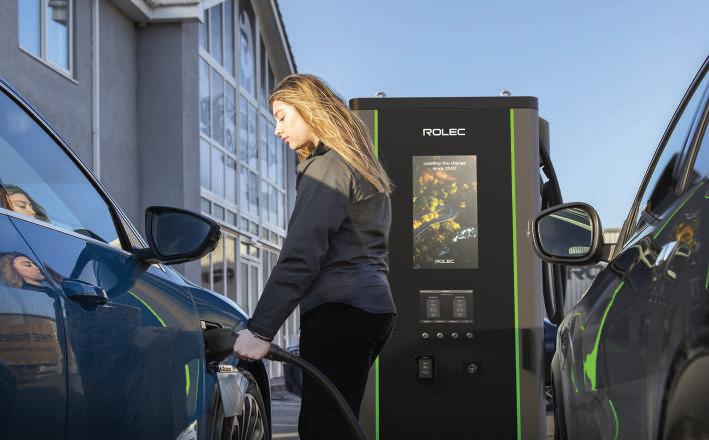
the UltraCharge 80 is a great option for businesses looking to future-proof their charging network. It now has a sleeker look and dual output with intelligent power sharing. It is best suited for busy commercial and public transport sites, dealerships, and depots.
This unit delivers up to 80kW of charging potential and maximises space without limiting power – offering dual charging capabilities using intelligent, dynamic power sharing via 5m 250A Peak and 150A Nominal charging cables capable of delivering 80kW charge rate to a standard 400V vehicle, adaptively designating charge to the vehicle with less battery.
The UltraCharge 180 is a high-performance charger built for high-traffic environments such as motorways, retail outlets and shopping centres. It features an integrated advertising screen as standard for additional ROI. It is capable of simultaneous vehicle charging via dual 5m 350A peak and 250A nominal CCS2 universal charging cables.
Fully tolerant to the needs of your site, the unit can be up or downgraded in 30kW increments from 120kW up to 180kW of power.
Like the rest of the range, the UltraCharge 180 is fitted with the latest safety features, including under/over voltage, DC overcurrent, over-temp and surge protection and built-in 30mA Type A RCD protection as standard, IK10 impact protection rating and IP54 weatherproofing.
Finally, the UltraCharge 400 delivers ultra-rapid charging at scale, with modular power upgrades from 200kW up to 400kW, supporting dual-vehicle charging. Thanks to its 150V-1000V dual power output segment, the unit has an improved power utilisation

ratio, speeding up charging times and maximising revenue by decreasing vehicle downtime. Additionally this means the UltraCharge 400 can not only meet the low voltage charging needs of conventional EVs but also the requirements for charging larger commercial vehicles such as HGVs, electric trucks, buses and boats. It can deliver up to 80% charge in under 10 minutes.
Each unit is built for reliable performance, with future-ready connectivity (Wi-Fi, ethernet and 4G), and full compliance with PAS 1899 standards, making it easy to use.
For additional flexibility to your network, charging can be controlled either via plug & go, RFID, any OCPP app of your preference, or contactless payment for pay-to-charge.
Frequent over-the-air updates also allows the chargers to receive the very latest features, ensuring a resilient, secure and available product 24/7. While robust construction, and versatile mounting options ensure broad site compatibility.
All models integrate effortlessly with Rolec’s 40+ charge point management partners, supporting businesses and organisations of every size and scale with your needs.
“Our new UltraCharge lineup reflects Rolec’s commitment to delivering flexible, cost-efficient, and future-focused solutions that meet the evolving demands of fleet and public EV infrastructure,” says Frankie Mellon. “We’ve upgraded the standard specifications while maintaining competitive pricing. This portfolio combines advanced functionality with a broader range of power outputs –designed to maximise performance, scalability, and ROI.”

IN TODAY’S business climate, where rising costs and talent shortages go hand in hand, companies are starting to rethink how they attract and retain great people. Offering meaningful, low-cost benefits has become more than a perk; it is now a strategic tool. One benefit that stands out to us is the car salary sacrifice scheme, particularly when focused on electric vehicles.
What is a car salary sacrifice scheme?
A car salary sacrifice scheme allows employees to give up a portion of their gross salary in return for a fully maintained vehicle, usually an electric one. Since payments are made before tax and National Insurance, employees save money and gain access to a new car that comes with insurance, servicing, breakdown cover, and maintenance, all in a fixed monthly cost.
Employers benefit too. By reducing gross salaries, they lower their National Insurance contributions and, in some cases, pension obligations.
With Benefit in Kind (BiK) tax on electric vehicles currently at just 2%, this setup is one of the most efficient ways to deliver value to both sides.
More than a perk, it’s business strategy
The numbers speak for themselves. In a recent episode of the Different Hats podcast, one company helped a high-earning employee swap a traditional car allowance for a salary exchange agreement. The result was thousands saved in tax for both the employee and the employer.
However, it goes further than tax savings! Staff retention remains one of the biggest hidden costs to any business. Replacing a team member can cost 10% to 20% of their salary, not to mention lost time and disruption. By providing a benefit that people value, the idea is to reduce employee turnover, as they may not want to give up on their employer as easily. Car salary sacrifice fills this mould as a useful benefit perfectly.
Modern employees expect more than just a payslip. Wellbeing, financial security, and sustainability now rank higher than ever. A salary sacrifice scheme touches all three. It supports lower running costs for transport, gives access to newer, safer cars, and reinforces the company’s commitment to sustainability.
As discussed on the podcast, there’s also a “stickiness” factor. Employees who commit to a two or three-year lease are less likely to leave while it is in place. The car becomes a daily reminder of the employer’s investment in their wellbeing.

“Imagine being able to offer a new Tesla Model 3 as part of your package. It is a compelling benefit that costs less than a traditional pay rise...”
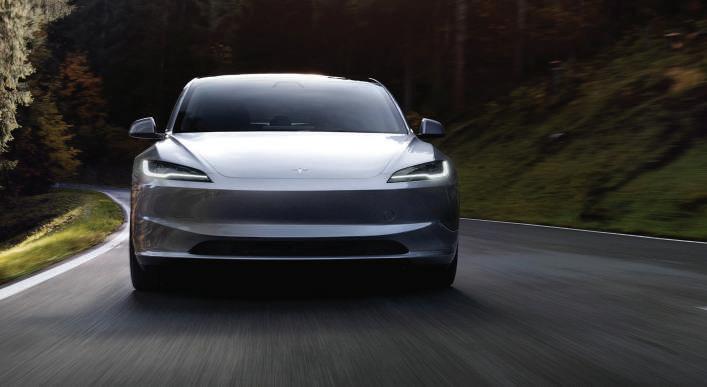
What about the risks?
No benefit is one size fits all, and salary sacrifice is no different. It is not suitable for employees on lower wages, as take-home pay cannot fall below the legal minimum. A lower gross salary may also affect mortgage applications or statutory benefits like parental leave pay.
However, the scheme is optional and most providers include early termination protection. This means that if someone resigns, goes on maternity leave, or becomes unwell, the business is not left carrying the cost. Properly structured, the scheme is low risk and high value.
There is also the credit consideration. Each lease sits under the business’s name, so employers need to plan for the potential number of agreements. Still, with clear processes and a trusted provider, this becomes manageable.
Why electric vehicles?
While salary sacrifice can technically be used for any vehicle, it works best with electric cars. BiK tax for EVs is fixed at 2% until 2025 and will rise only slightly up to 2030. That makes EVs far more efficient to run through a scheme like this.
Charging costs are significantly lower too. A home charge can cost around 5p per mile, compared to 15 to 20p for petrol or diesel. Some schemes even include a home charger and support with installation. For those without access to home charging, public infrastructure continues to grow, and workplace chargers are an increasingly popular solution.
An ESG and brand advantage
Offering a scheme like this does more than reduce carbon emissions; it enhances your employer brand. Whether you’re trying to win

tenders, recruit younger talent, or show investors you’re serious about ESG, salary sacrifice sends the right message. In a competitive job market, this could be the difference between a candidate choosing your business or another.
Imagine being able to offer a new Tesla Model 3 as part of your package. It is a compelling, high-value benefit that costs less than a traditional pay rise.
Getting started is simpler than you think Launching a car salary sacrifice scheme does not require a large HR or finance team. Most providers support setup, including documentation, payroll integration, and staff communications. You can start with a small group and scale over time. Communication is key. As employees often do not realise the savings until they see a quote. Running webinars, sharing FAQs, and offering one-onone consultations make a big difference in uptake and trust.
The bottom line
Salary sacrifice schemes for electric vehicles are more than just a modern benefit. They offer a cost-effective, flexible way for businesses to reward staff, reduce emissions, and protect their bottom line.
Whether you are an SME looking to compete for talent or a larger organisation aiming to boost retention and meet ESG goals, this is a benefit that delivers real impact.

Search Rivervale Salary Sacrifice or scan the QR code to find out more

Cupra now has two electric cars. Following the Born, one of our favourite EVs, the Spanish auto brand has added the larger Tavascan. A striking 5-door SUV coupé, we got behind the wheel recently of a VZ1 model to find out more.
The Tavascan comes in four specs. Entry level V1, then V2, VZ1 and range topper VZ2. V1 and V2 are Rear Wheel Drive and come with 282bhp, VZ1 and VZ2 feature two motors so more offer power at 335bhp and are All Wheel Drive. All versions are fitted with a 77kWh battery.
V1 costs from £47,350, V2, £53,385, the VZ1 is £55,495 and VZ2 is £60,45.
Specifications
With prices like that you’d expect the Tavascan to come well equipped – and it doesn’t disappoint. V1 features 19” alloys, a 15” navigation system, 5.3” digital cockpit, CUPRA Connect, CUPRA Connect Plus, two front and two rear USB’s, wireless smartphone integration, a wireless charger, DAB, bucket seats, copper interior detailing, a rear view camera, Drive Profile – Range, Comfort, Performance, CUPRA, Individual –Travel Assist, Predictive Adaptive cruise control, Intelligent Park Assist and Traffic Sign Recognition.
As you move up you add 12-way electrical adjustment to the bucket seats, heated front seats, a rear arm rest, ambient lighting, a double floor in the boot and 21” alloys. VZ1 is specced as per the V2 but adds AWD with more power at 340PS battery, while VZ2 offers ventilated front seats, CUP Hero leather and 21” Etna forged alloys. All versions come with a Type 2 charging cable.
Outside and inside
Cupras are built on the same platforms as electric Volkswagens, Skodas and Audis, but their USPs are sportier and more aggressive. From its high curved corner front lights and large Cupra logo at the front, to the copper infused alloys and sharp lines at the side and with the slim rear car-width light bar and spoiler, it’s a looker.
Inside there’s plenty of copper detail and the plastics look and feel hard wearing. Soft finishes around the centre console and on top of the centre armrest look and feel lovely.
A 15” touchscreen dominates the centre top dash. The operating system and menus are easy to navigate and it’s relatively easy to turn off the safety features.
Climate control switches are a bit fiddly, and the digital drivers display is a little small, meaning the additional heads-up display on our VZ1 was a useful addition.
The glove box is small, but you do get split


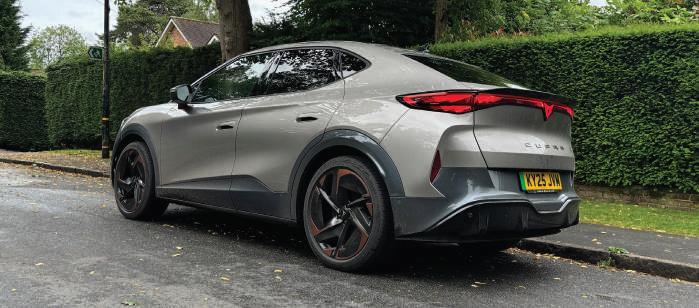
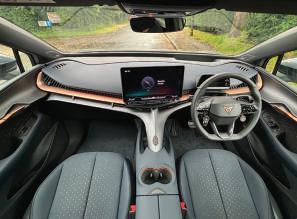

opening under arm storage, twin centre cup holders, two front and two rear USB.
The driving position is good with decent support from the bucket seats. Rear visibility is a little compromised by the low roofline and small rear window, and this worsens in the wet as there’s no rear wiper.
Back seat space is surprisingly good, with plenty of head and legroom and at a push, there’s room for three adults.
Performance and driving modes
It’s brisk. V1 and V2 fitted with the single motor and smaller battery will accelerate from 0-62mph in just 6.8 seconds. Select the dual-motor version with 335bhp and you release 545Nm of torque so a swifter 5.5 seconds from 0-62mph is possible.
You can utilise Comfort or Range modes to dial down the aggression and improve range.
Charging and range
AC 11kW is available on all versions, so a 0-100% charge will take eight hours. Away from home the Tavascan comes with 135kW DC charging , so a 10-80% top-up on fast chargers can be as quick as 28 minutes.
We topped the Tavascan up to full overnight on our Rolec box to a range of 273 miles. Even on a 100-mile motorway jaunt at a constant 70mph, the Tavascan returned a one mile driven to one mile of range used, which is impressive. It averaged 3.8 miles/ kWh, better than many competitors.
Driving
Despite the power under the bonnet, the Tavascan handles nicely on local routes and in town centres. To start-up you push the brake
and the engine starts. You can then select D or B for regeneration from the right side steering wheel stalk.
Even though the rear windows is narrow, the on-board parking sensors and camera make urban driving straightforward and the auto-hold means you can relax at lights and junctions.
The ride is a little on the firm side, probably not aided by our test car’s larger 21” wheels. However, the damping softens things up considerably compared its predecessor.
Head out onto better driving roads and despite the car’s 2,267kg kerb weight, the steering is light and nicely weighted.
If we have a criticism it’s with the brakes which are lacking any feedback, especially in regeneration mode, which makes the car a bit harder to slow down than you’d expect. The regeneration can be adjusted via the steering wheel paddles but it never feels that strong and is definitely not one-pedal.
The Tavascan is both good fun to drive and looks good too. It also features a stylish comfortable cabin and comes well equipped. The largeish battery offers close to 300 miles of driving range and charging speeds are decent too.
All versions don’t come cheap. A slightly firm ride on larger wheels and a lack of feedback from the brakes are our only criticisms.
Excellent addition to the electric car market. Much more exciting proposition than many competitors. Firm ride harks back to Cupras of old. It’s practical too. But it is pricey, and we’d suggest leasing one.
If you’re looking for an electric car that offers some excitement as well as practicality the Tavascan is well worth your time.
CC&V RATING: N N N N

A RAPIDLY-GROWING telecoms installation company has bought 10 new vans for its engineers, adding to a fleet which is expected to grow to 50 by the end of the year.
Formed at the start of 2024 and based in Formby in Merseyside, TG Telecoms is forecasting to increase its turnover to over £10m in 2025.
Working with telecoms and utility providers, the company surveys, manages and installs telecoms services for the UK’s private internet access (PIA) network, mainly for residential customers but also for businesses.
Part of the Tower Grange Group, it was set up under the ownership of experienced telecoms expert Stephen Sullivan and banker and finance professional Steve Peck.
Supported by commercial director James Harman, strategy and development director Gavin Collier and a team of senior staff across the business, the company has ambitious plans for growth.
A key strategic partnership will be the relationship with Bristol-based vehicles broker Vanaways, who Mr Collier says will provide all the Ford Transit Custom vans it needs over coming months.
“The residential installs side of our business is growing rapidly,” he said, “and we’re planning a massive recruitment drive to have 50 engineers working for us by November.


“Each will need a van to carry fibre, cobra rods, splicing machines and all the other tools and materials they’ll need to do their work.
“As such it’s vital for us to have a reliable vehicles supplier who is focused on providing the best possible solution for us, quickly and flexibly.
“We’ve decided to purchase rather than lease the vehicles so that we have an asset in the business rather than a liability, and we know that with Vanaways we’ll be supplied them at the best possible fit for our requirements.
“On a personal note, I’ve worked with Liam Nicholas from Vanaways for several years and we have a strong relationship based on trust and mutual benefit. We’re excited to work together for the next phase in the growth of TG Telecoms.”
Vanaways has recently revealed plans to double turnover to £200m by 2026, as it celebrates its 10th anniversary in business.
The Bristol-based company has seen spectacular growth since Covid-19, with turnover rising from £15m in 2020 to £109m in 2023/4.
Liam Nicholas, business development director at Vanaways, said: “The team at TG Telecoms shares our values for industry innovation and a people-focused culture, so it’s great to be on board with them as preferred vehicles supplier.
“Of course with the internet continuing to play an increasingly important part of people’s lives and their businesses, the opportunities for future growth at TG are clear.
“We’re delighted to supply their engineers across the UK with the vehicles they need and we’ll support as TG continues to grow and diversify into other sectors.”
The finance for TG’s purchase was brokered by Simply Asset Finance, whose area sales manager Adam Cooper said: “It’s been an absolute pleasure dealing with TG Telecoms, a company with a clear, exciting plan for moving forward. Our bespoke finance package, fitting the customer’s requirements with the vehicle delivery schedule, demonstrates the great partnership Simply Asset Finance and Vanaways have in supporting British SMEs.”
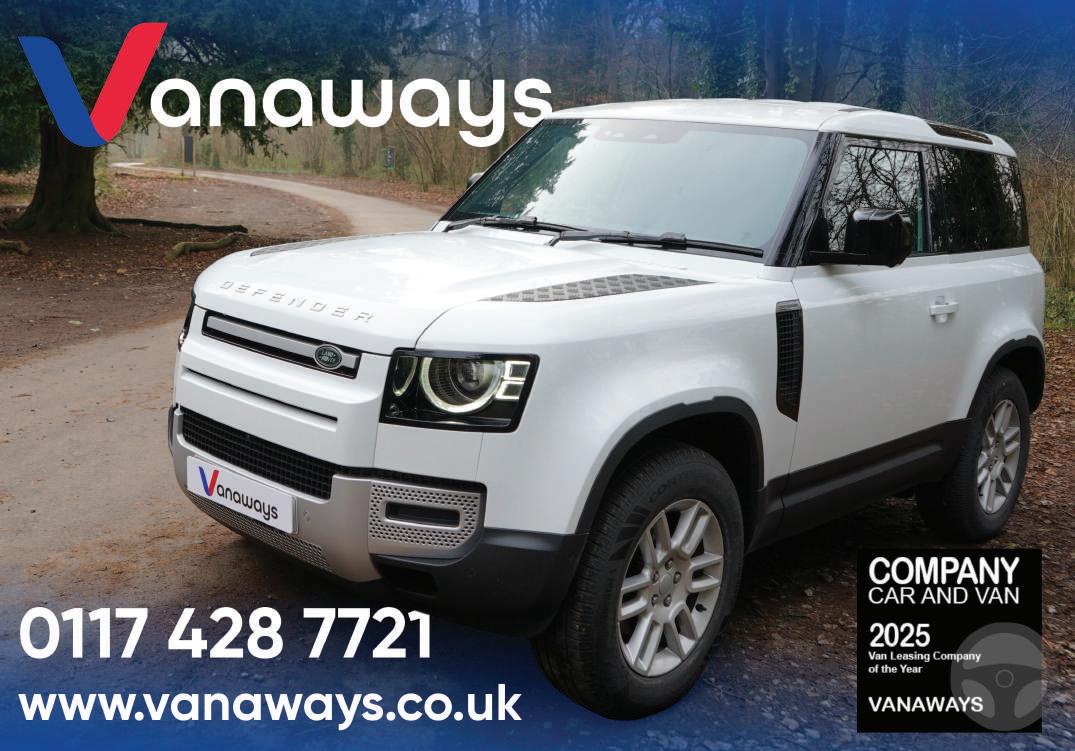
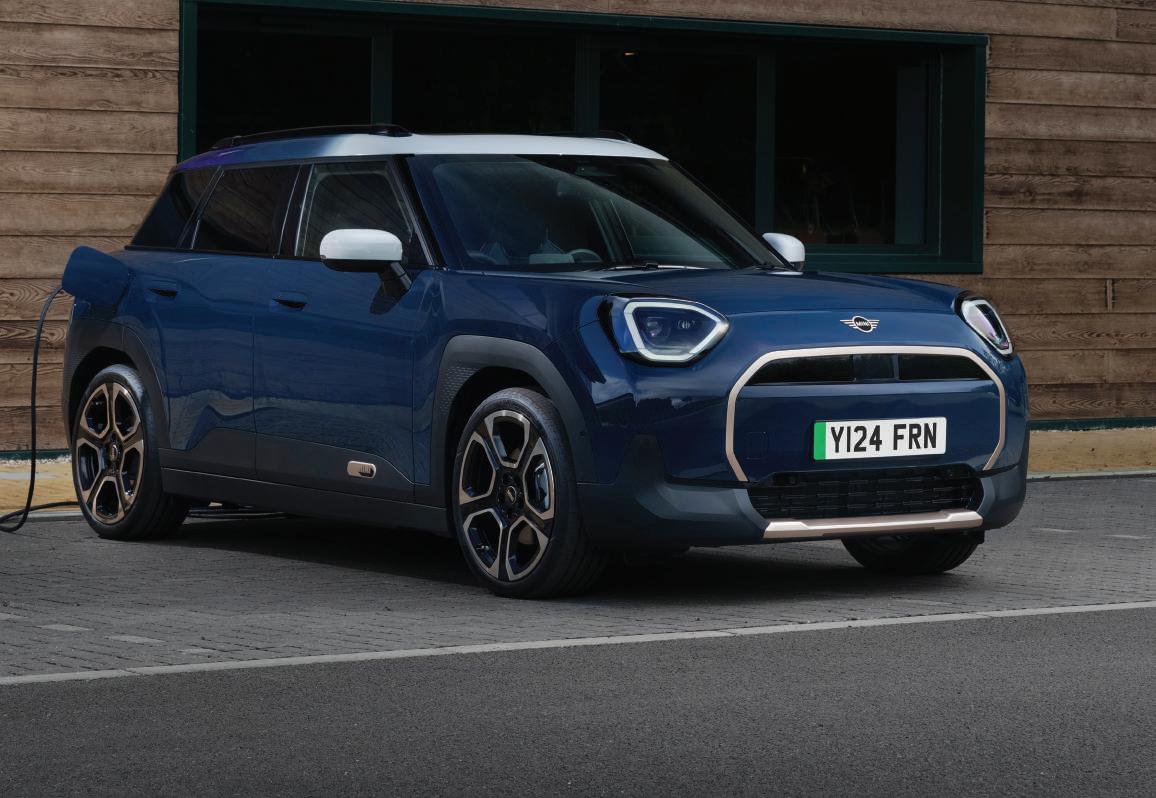
The MINI Aceman combines hatchback hustle with SUV muscle. It features five seats and if you fold down the seats, a 1,005 litre boot. Maximum range of up to 252 miles in SE guise. As with the the Cooper its MINI heritage is clear to see both inside and out, while on the road it retains MINI’s famous driving experience.
Follow the QR code!

The all-electric MINI range consists of the MINI Cooper, MINI Aceman and MINI Countryman, models that offer fleet customers increased driving range, high levels of standard equipment and tech, while still offering a quintessential MINI styling and driving feel with an electric powertrain.
The MINI Countryman Electric was named as Company Car & Van magazine’s Medium Car of the Year for 2025, while the all-electric MINI Cooper is Business Car magazine’s current Car of the Year and Small Car of the Year.
With three electric models, MINI means more than business as usual. All are smart, practical, stylish and seriously fun. With just 3% BIK, they’re built for business and come backed by MINI’s extensive corporate network and service programme.
But don’t take our word for it, test drive one now at your local MINI Retailer.
MINI is the Company Car & Van’s Corporate Manufacturer of the Year. It won this accolade thanks to a combination of its MINI For Business sales programme, which is aimed at SMEs, and the brand’s network of National Key Account Managers, who are the point of contact for larger fleets and businesses. Plus there’s a MINI Retailer corporate sales team to help with any enquiry.
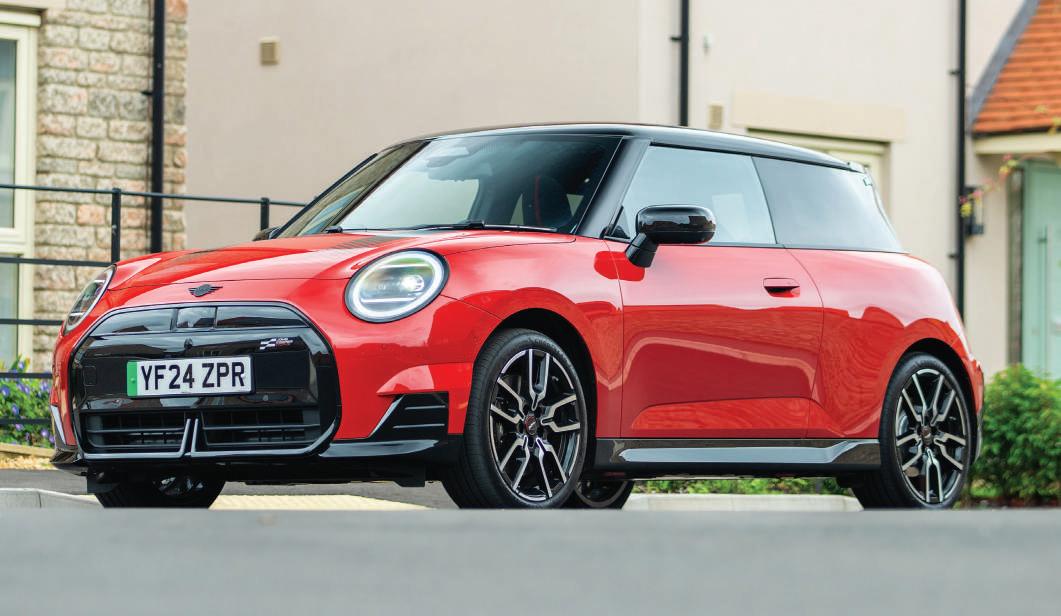


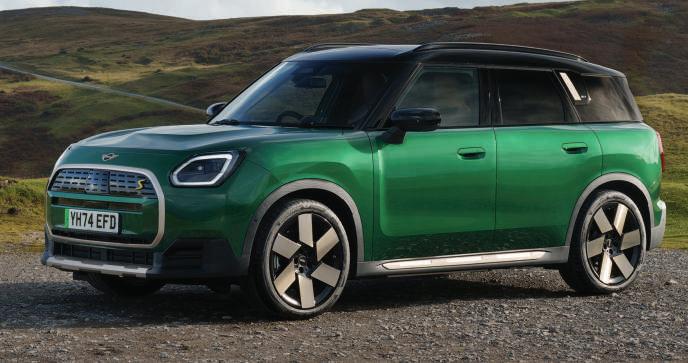

The all-electric MINI Cooper takes the MINI DNA and moves it into an electric future. Cooper comes with a maximum range of up to 249 miles in SE spec while offering MINI’s legendary go-kart feel. It’s practical too, with a maximum boot capacity of 800 litres with the rear seats folded down.
The largest MINI offers a maximum driving range of up to 287 miles and 1,450 litre boot capacity with the seats folded down. Countryman is a roomy, comfortable car that’s a lot more fun to drive than anything in the class, while offering a practical fiveseat interior sprinkled with large dollops of MINI DNA.
Fuel economy figures and CO2 results for the MINI electric range: Mpg (1/1000km): Not applicable. CO2 emissions: 0g/km. Electric range 182 – 287 miles. e MINI electric models are battery electric vehicles requiring mains electricity for charging. Whilst recommended the battery for these vehicles are charged to 80% to help optimise the life of your battery, the electric range figure shown is the WLTP figure after the battery had been charged to 100%. WLPT figures are shown for comparability purposes. Only compare fuel consumption, CO2 and electric range figures with other cars tested to the same technical procedures. ese figures may not reflect real life driving results which will depend on a number of factors including the starting charge of the battery, accessories fitted (post registration), variations in weather, driving styles and vehicle load.
From servicing to spare parts, the MINI Service Inclusive package has you covered. It’s all business. All pleasure. All taken care of through MINI’s Corporate Certified programme that’s backed by a strong retail network offering quality aftercare.



Following the roll-out of the latest generation Mini family, the brand has introduced a John Cooper Works MINI Electric and Aceman. CC&V journeyed to Stow in the Wold to drive them both. First up the Aceman...
COSTING from £42,220, the electric Aceman JCW is fitted with a 54.2kWh battery which offers 258hp and 340Nm of torque. Top speed is 124mph and 0-62mph takes just 6.4 seconds.
Mini’s engineers have developed an all-new electric boost function to further enhance power delivery, giving the driver an additional 20kW of electric motor power once John Cooper Works mode has been activated.
The JCW suspension maximises handling, while high performance grip tyres come as standard on all electric John Cooper Works models.
The exterior design comes with a more aggressive appearance. There’s a red, white and black John Cooper Works logo, gloss black trim is standard, so black side skirts and aeroblades at C-pillar level. Plus there’s a rear spoiler with red vertical reflectors and diffusers that contrast with the rear black apron.
An aerodynamically optimised 19” wheel design in black with red accents is available exclusively on electric Aceman, with Chili Red brake callipers sporting a white JCW logo and a Chili Red roof are standard, with a multitone black to red roof available optionally. It all looks fantastic.
The black and red JCW colour scheme continues inside the vehicle, where a black and red pattern decorates the knitted surface of the dashboard. The driver and front passenger seats are upholstered in black synthetic leather with multi-coloured knitted fabric at the shoulders and red accent stitching, while the ambient interior lighting illuminates the headlining as a JCW model exclusive feature.
The system fitted to the Aceman is called the MINI ‘Interaction Unit’ and it runs an Android-based System 9 operating software. This has been specifically designed to look and feel similar to a modern smartphone, so you can stream video and play games on it too. It also offers the MINI Experience Modes whereby you can configure different settings Core, Green, Go-Kart, Vibrant, Timeless, Balance and Personal.
Only three of those modes – Go-Kart, Core and Green – actually change the way the Aceman drives, by either altering the levels of regenerative braking allowing for an increased range, lightening or tightening the steering most noticeable in town and will increase or decrease accelerator response, something you’ll get hooked on in Go Kart mode.

Among other special kit our test Aceman came as standard with a heated steering wheel, John Cooper Works steering wheel, anthracite roof lining, John Cooper Works sports seats, charging cable , AC Fast Charge preparation, Sport Trim, DAB, Mini Experience Modes and a Harman/Kardon Surround Sound Audio System.
You can choose different levels of extras, with our test car adding Level 3’s panoramic glass sunroof, sun protection glass, folding wing mirrors with auto-dimming, rear-view mirror with auto dimming, Active Seat for driver, electric memory seats, heated front seats, an interior camera, adaptive LED headlights, High-Beam Assistant, Driving Assistant Plus, Parking Assistant Plus, MINI Head-up Display, MINI SatNav and storage for wireless charging. All that will set you back an additional £3,800.
The Aceman John Cooper Works Electric can be charged via 11 kW AC and up to 95 kW DC, meaning at a fast-charging station, the battery can be charged from 10 to 80 per cent in under 30 minutes.
Plug-in at home overnight on an EV tariff and enjoy 9p a kWh for 5 hours and add 37kWh for £3.30. Our new Rolec Evo is well worth considering as your home charger
https://www.rolecserv.com/ev-products/ evo
If you’re on a longer journey, using MINI Nav, the vehicle will ensure the battery reaches the ideal temperature for efficient charging in advance, thus reducing charging time.
Customers can also optimise charging for their schedule, setting charging start times, active charging windows and battery capacity by departure time via the MINI app.
There’s more room in the rear than the original Mini five-door, and that’s a good start. Up-front you now sit a little higher to accommodate the battery. Front seat passengers get loads of seat adjustment, while in the back headroom is good and legroom impressive, too. Boot space is 300 litres but this increases if you fold the 60/40 split rear seats down to 1,005 litres.
On the road it’s just as good as we expected. Mini’s engineers succeeded in creating a proper Mini driving experience which the Aceman and the JCW version extends. At 1,720kg it’s heavy which should in theory ruin the fun. But it most definitely doesn’t. Whether you play it safe in the Green driving mode, select the middle ground with Core or go mad for Go-Kart, all three modes offer the driver plenty of fun.
On some very driveable roads, we’re pleased to report that the steering is light and very well balanced, and the brakes are amazing. So you can, as we did, break out in a broad smile as the Aceman powers in out of corners, hugging the road like glue. We think it’s a marginally better performer than the Cooper and Countryman, probably because its dimensions equate to, in our opinion, the perfect size for a small battery electric vehicle. The extra power just means a broad Cheshire Cat grin.


We’ve praised it on a country road, but what about in town? A short drive saw us arrive in Stow where we drove along the main high street and around the town centre. The Aceman’s quiet to drive in traffic and when we stopped for a coffee, was easy to park too.
We returned to base via Broadway and a short hop on the M5 and with adaptive cruise control selected plus that instant torque, this was highly enjoyable too. At 70mph, the Aceman remains quiet and although the JCW seats are a little hard, cabin comfort is impressive with plenty of room in the front. Even in the rear two six-footers will have head and legroom to spare, quite an achievement for this compact car.
Any negatives? The infotainment screen looks fantastic, but it contains all of the driver info. The constant need to glance left to read these could be a touch distracting, and as for the climate controls, annoyingly you adjust

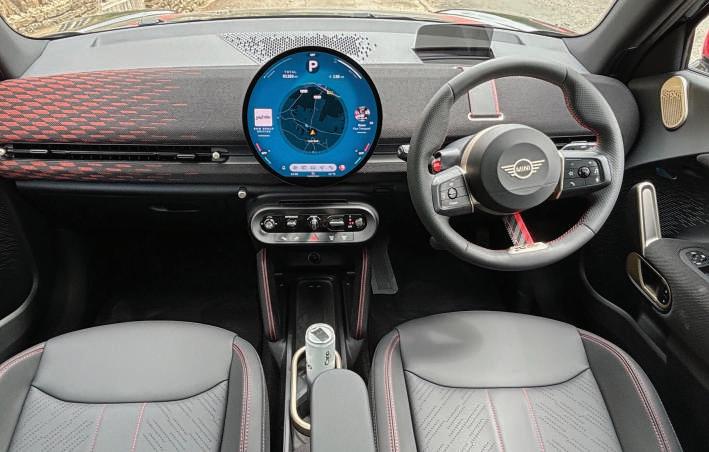

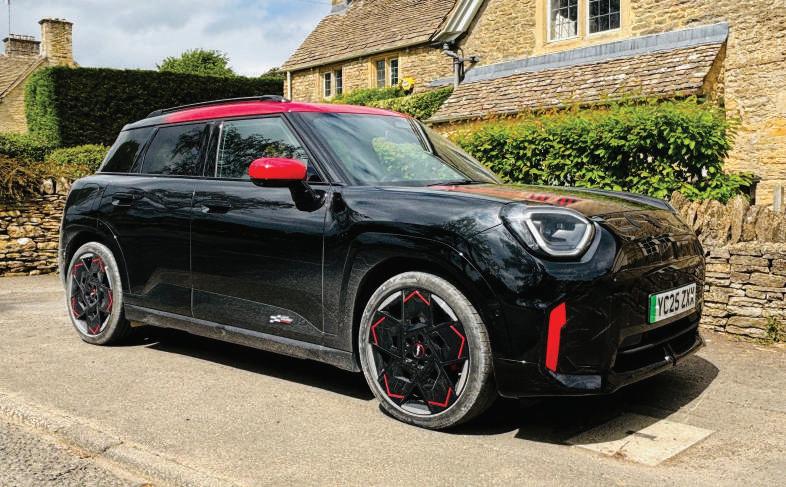
the temperature using two tiny sliders which are located at 5 and 7 o’clock on the touchscreen. In MINI’s defence we’ve spent more time in the new model now and it does get more familiar .
The Heads-Up display fitted to our test car is well worth considering and this comes with the Level 3 pack. And if you’re wondering, then yes, like all electric cars, you can feel the battery weight primarily when you drive over poor road surfaces and it’s just as fidgety as all similar sized electric cars in that respect.
Pros
Looks fantastic, high quality interior, decent range, fast charging and as brilliant to drive as Minis of old. Low BIK too.
Cons
Adding extra packs can get expensive. Perhaps separate climate controls would have been a good idea. More expensive than a standard Aceman which is a great car anyway.

The John Cooper Works Electric Aceman delivers plenty of Mini magic and we had a blast driving it and you’ll never get bored of its smile inducing road manners. On board fast charging is a bonus and range is about par for the sector, so don’t let 250 miles put you off.
More good news is that it’s roomy enough to fit four adults and features a useful sized boot. Throw in the Mini DNA best illustrated by the circular infotainment screen and toggle switches plus the JCW badge and accoutrements and it’s another winner.
CC&V RATING: N N N N


THE Skoda Enyaq had some updates for 2025, and one of our favourite electric SUV’s has only got better. A few hundred miles in one proved that it’s still one of our favourite electric cars, although sister model Elroq gives it a serious run fort it’s money.
Pragmatic Skoda
Skoda is renowned as a well built, reliable car brand. As part of the Volkswagen family, all of its models share their mechanics with Volkswagen, Audi and Seat, and the Enyaq is no different. It uses the same platform, batteries and electric motors as the Volkswagen ID.4. However, where the ID.4 is a little bit out there, the Enyaq is a more conservative, but all the better for that.
What’s new?
From the outside Enyaq is the latest Skoda to gain the brand’s new Tech-Deck face, so there is a new-look, flush-fit front grille, a deeper, more chiselled front bumper, thinner LED headlamps and new taillights.
Battery ranges have slightly increased across the range, while higher-spec Enyaq’s have received a power boost. On 85 and 85x models you now have the option of bidirectional charging for the first time, so you can use the car to recharge larger electrical items.
Trim levels were also revised but Skoda kept the Enyaq range pretty simple to

understand. You now have the choice of 60, 85, 85x and vRS variants. Two battery sizes are also available: 63kWh and 82kWh units. The base model Enyaq 60 gets the smaller battery pack for a range of up to 269 miles on the WLTP combined cycle. Upgrading to the Enyaq 85 with its larger battery boosts the official claimed range up to 358 miles.
There are four Enyaq models available: SE L, Edition, Sportline and vRS variants. All models can be paired to Skoda’s specs, called ‘Design Selections.’ So choose from Loft, Lodge, Lounge, Suite Cognac, Suite Black plus a SportLine model for 85x and which is also available on the 80. Standard spec is Loft and it features black and grey tones with comfortable fabrics, plus fabric door inserts. Lodge includes a selection of eco-friendly materials, so for example, the seat covers are 40% natural wool and 60% polyester from recycled bottles.
Lounge gets more exciting and features black leather and mustard stitching, with microfibre upholstery including fabric on the top of the dashboard that’s designed to compliment the seats. Suite comes next with cognac-coloured stitching and then EcoSuite, which focuses on environmentally friendly touches. These include fake leather door inserts and interior leather, that’s tanned using sustainable olive trees.

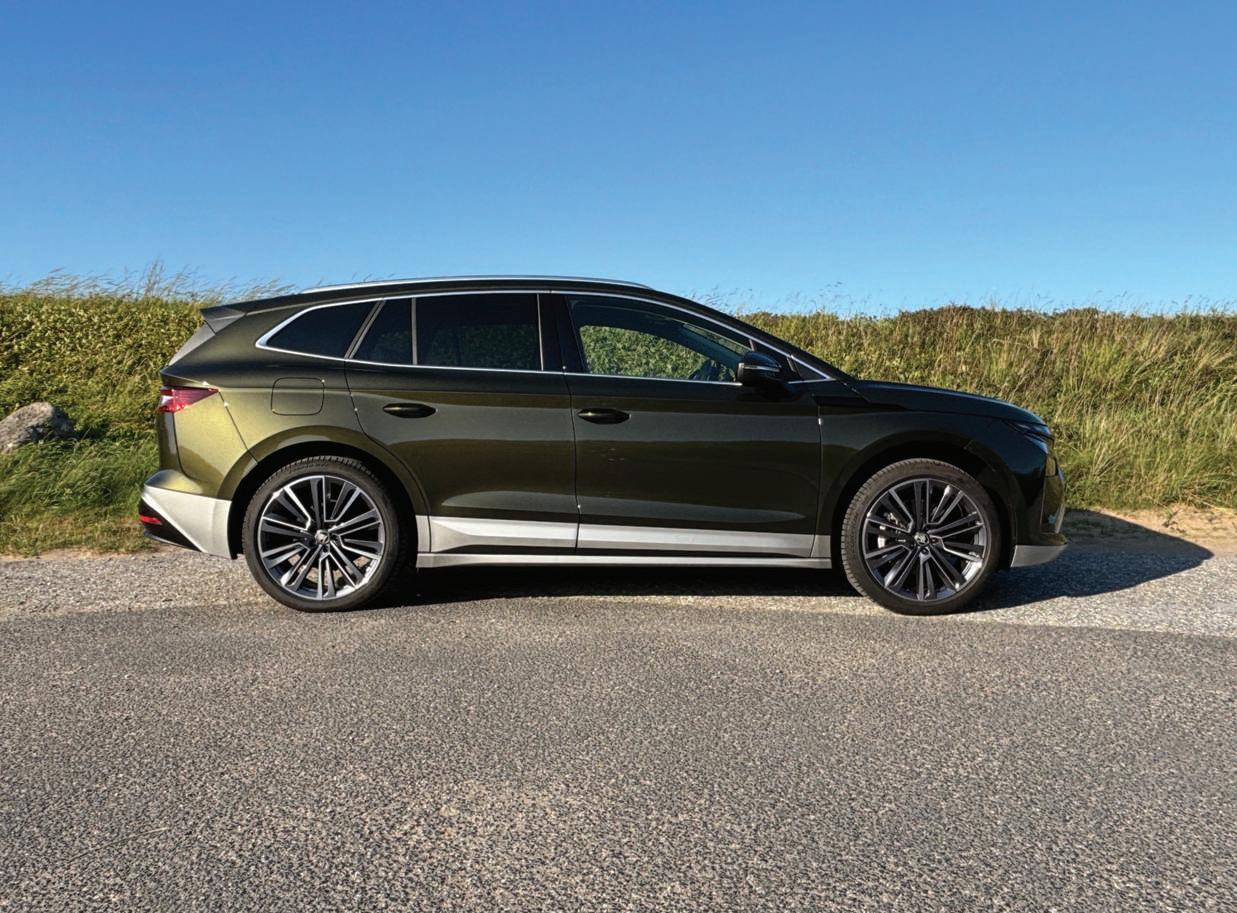
All Enyaqs come with a cable for home wallbox charging as standard. We recommend Rolec; http://www.rolecserv. com/home-charging
Maximum charge rates for the 60 and 80 are 135kW while the 85x will push out 175kW. When we did plug our 85 in it was mainly at home overnight to take advantage of cheap electricity tariffs, adding 38kWh for just £3.30.
You’d be forgiven for thinking that the Enyaq is the more upmarket EV than the ID.4, because the interior is excellent. Where the Volkswagen goes for quirkiness, the Skoda goes by the book, so what you get is a safer, cleaner dashboard with many of the touches you’ll find in every Skoda. So, for example, the automatic gear leaver is located in the centre binnacle, not on the right of the steering wheel as in ID.4.
The updates include a new steering wheel, heated front seats and tri-zone climate across the range, only add to its appeal.
The materials used throughout are really high quality and we especially liked the dashboard trim. The colours are a little bland though, grey with grey and more grey.
Plump for the more expensive 85 and you’ll get front parking sensors, a rear-view camera and a heated steering wheel. 85x
SportLine models get more aggressive styling, plus 20” wheels, matrix-LED headlights and a slightly lowered suspension and features AWD and 125kW rapid-charging.
Infotainment and connectivity
All models feature a 13” infotainment system with SatNav, Apple CarPlay and Android Auto, dual-zone climate control, keyless go, rear parking sensors and ambient lighting. Up front are twin C USB inputs and an electronic hand brake.
Most of the functions are controlled via the touchscreen, although there are some physical buttons underneath to access the climate if required and to turn off some safety features as desired. Cruise control can be found on the left steering wheel column.
The infotainment system itself is very intuitive and it doesn’t take to long to grasp its finer points. The screen is easy to reach and the menus are straightforward. The on screen graphics are clear and sharp and the set-up is very responsive.
As long as you have the key on you, the Enyaq will unlock itself and when you push the brake pedal the engine will start. Select Drive and away you go. When you come to stop, you just press Park, get out and the car will switch itself off and lock behind you. Connecting to Apple CarPlay was seamless.
In the cabin there’s acres of room up front and plenty of space for three adults to get comfortable in the back. For odds and sods, there’s a storage bin between the seats, a tray beneath the centre console, an under armrest cubby, a decent glovebox and largish door pockets.
The boot measures 585 litres, with space to keep the charging cables under the boot floor. Fold the rear seats flat and there’s 1,710-litres on offer. This was more than enough space for my bike to fit in. And being a Skoda, extras such as an umbrella, hidden in the driver’s door, an ice scraper, removable glass cases and useful storage box for rear passengers are also included. Whichever way you look at it, this is a very practical car !
Current BIK on the Enyaq is just 3%. The entry-level Enyaq SE L model with 60 battery starts at around £39,000, with the Edition variant starting at just over £40,000. Sportline comes in at £47,260 and at the top end, the high-performance Enyaq vRS comes in at £51,660, all with the larger 85 battery.
The entry-level 60 uses a 201bhp, rearmounted electric motor for a 0-62mph time of 8.1seconds, while the 85 uses a more powerful 282bhp unit for a 0-62mph time of 6.7 seconds. 85x, meanwhile, gets an extra asynchronous motor on the front axle for
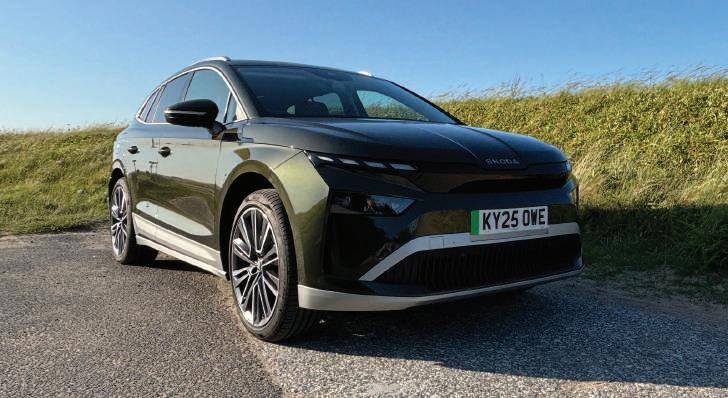



all-wheel drive running withe the same acceleration time and 112mph top speed.
Our 85 Edition is no slouch coming as it does with 286PS and 545Nm on the rear and 124Nm on the front, so a 0-62 sprint is a rapid 6.6 seconds. Top speed is 111 mph. Motorway driving is a cinch. Select Cruise Control and away you go. In town, you can take advantage of the Regeneration. The braking feeling associated with many EVs isn’t as strong in the Enyaq, which is a good thing. Simply select ‘B’ in the gear box to access. And we used it pretty much all of the time.
The Enyaq offers plenty of road holding and comes with accurate steering. The battery weight isn’t that noticeable, although the ride is on the firm side. There’s little or no road or wind noise entering the cabin. Lots of glass means manoeuvring is easy and all round visibility is excellent. In town it’s relaxing and on the motorway, a comfortable cruiser.
We undertook one longish journey in our week in the Enyaq, a 300-mile round trip. While we considered charging at the event we didn’t need to bother, as the 85x, which began with a range showing 329 miles, saw us reach Teesside with 187 miles left in the battery. Absolutely spot-on.
However, it’s worth noting that we didn’t exceed 70mph on the motorway and spent a good part of the journey in 60mph speed limits on the M62 and 50mph limits on the A1 for road works, which undoubtedly helped. Driving locally, the regenerative braking definitely adds miles to your range, we’d surmise as

much as 15%, which is more good news. So 350+ miles is a possibility. A caveat, is that we were test driving in early July. Driving in very cold weather will reduce battery range as will driving with more passengers on board.
The Enyaq is a practical, comfortable electric SUV and if you stick to the lower specs, incredible value for money compared to much of the competition. The more traditional interior set-up with plenty of function buttons is a refreshing change in a touchscreen obsessed industry. On the motorway or off, it rides well and hides the battery weight as well. Acceleration is brisk.
Cons
A little bland compared to rivals. Top-spec versions are expensive. Sister model Elroq is almost identical, slightly smaller and cheaper
The fact that the Enyaq is slightly more conservative in its styling than much of the competition is, for us, its greatest asset. Anybody can jump in and work out how to use the car’s functions really easily, which is a massive bonus if you’re new to an EV.
The Enyaq feels more grown up, better finished and a bit more logical than the likes of the VW ID.5, Ford Mustang Mach-E or even the newbies from China such as the BYD ATTO 3. Like these it’s a proper family five-seater, offering loads of practical space.
It also comes fitted out with on-trend tech and the latest safety features.
For company car drivers the BIK benefits are almost impossible to ignore.
Steer clear of the higher specs as with this level of standard kit on offer, there’s no need for them. Test one, you’ll not be disappointed.
CC&V RATING:
N N N N N

DESPITE the pressure coming from new carmakers in China, Mazda continues to plow its own path. When we met up with Mazda UK managing director Jeremy Thompson at the CX-80 launch he said as much, telling us that Mazda would continue to produce different cars and powertrains for different markets, with the recent unveiling of the electric Mazda 6e a teaser for what’s to come.
What is the CX-80?
The CX-80 is In effect a larger CX-60, offering six or seven-seat configurations. It’s 26mm taller and 25mm longer than the CX-60, with an identical width. It comes with the same engines as the Mazda CX-60, so there’s a plug-in hybrid combining a Skyactiv-G 2.5-litre four-cylinder petrol engine with a 129kW electric motor and a 17.8 kWh battery, or Mazda’s six-cylinder 254ps 3.3-litre e-Skyactiv D diesel engine with both engines mated to all-wheel drive.
Model trims
Five trims are on offer. Entry level is Exclusive-Line, the model we tested, and it has 18” alloys, black leather seat trim, heated front seats, the Mazda Mi-Drive Systeml, power tailgate, electric handbrake, stop start button, smart keyless entry, LED headlights, roof rails, dual-zone climate control, a 12.3” TFT colour centre display with Mazda Connect. Homura, Takumi and Takumi Plus add to this, with the latter PHEV model also offering the 150W AC and 1500W AC sockets. Prices start from £49,670 for the Exclusive Line up to Takumi Plus at £56,420, both in PHEV format.
Performance and CO2
The 0-62mph time is just 6.8 seconds with a top speed of 121mph. CO2 35g/km.
Exterior
It’s a larger CX-60 in profile. Compared to a BMW X5 or Audi Q5, the CX-80 is more rounded and features smoother lines, narrow front and rear light clusters, an indented front bumper, large Mazda grille and a high rear window.
Interior
We drove the entry level Exclusive Line and the interior is tasteful, with some top quality finishes on all surfaces. Even the lower down facia and glove box front quality are very good, as are the seat fabric, door finishes and the chrome and black instrumentation.
Practicality
Where the CX-60 doesn’t offer much more



space than the CX5, the CX-80 extends the wheelbase to accommodate two extra seats, admittedly with only enough room for children and younger teens. Access to the third row is easier than you’d expect with the second row sliding a long way forward. The middle row can also be moved separately as well, increasing or decreasing boot space as required.
With all rows of seats in position there’s 258 litres on offer, 687 litres with five seats and a whopping 1,971 litres in two seat mode.
The PHEV pairs a 2.5-litre turbocharged petrol engine with an electric motor for a combined 327hp and 500Nm of torque. In Sport mode you can dash from 0-62mph time in 6.8 seconds. For urban journeys the 17.8kWh battery will offer a 36-mile electric driving range. In our fleet customer sector, lower BIK is key and the plug-in really is the only company car choice.
Plug-in at home on a 7.4kWh wall box and you’ll fully replenish the battery in 2.5 hours, easily within the lower night time electricity tariff period. As for the claimed economy north of 170mpg, then the more you plug-in the more likely this will be, although with such a large 2.5 petrol engine we’d surmise that 40-45 mpg would be a good result.
As a result BIK is currently 12%, rising to 13% for the 25/26 tax year.
Driving
The good news is that the larger CX-80

PHEV rides and handles better than the smaller CX-60. The AWD system sends more power to the rear wheels, giving a more balanced ride than in the smaller Mazda. The 18” alloys feel a bit fidgety, but it’s not too bad and in all honesty most customers won’t notice this. Better news is that the CX-80 handles corners and tight turns with aplomb, making a nonsense of its size and weight – it’s just 5cm shorter than a Range Rover – which would suggest it shouldn’t be any good at this at all. Weighing at well over 2,000kg you need to good brakes to come to a halt quickly in the CX-80 and it delivers here as well.
Pros
The clever interior is beautifully crafted. The seven-seat configuration makes it a practical choice. Lowish BIK means it’s an attractive company car offering. Handles better than a car this size should.
Cons
Not the smoothest engine nor best electric range in the sector. Entry level Exclusive Line doesn’t have adaptive cruise control.
CC&V VERDICT
A seven-seater plug-in that’s a little bit different to the established German & Swedish offerings.
It’s also practical for a large SUV & smacks of quality throughout. Mazda build the nicest Japanese cars.
CC&V RATING: N N N N


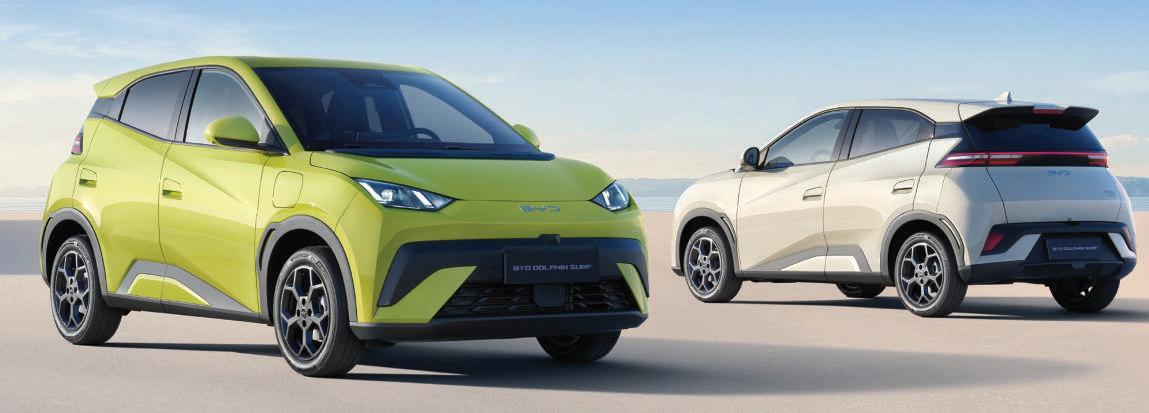

BYD, the world’s leading manufacturer of new-energy vehicles, has brought the DOLPHIN SURF to the UK. It’s BYD’s most accessible model yet, with prices starting at just £21,950.
For that you get sporty looks and a funloving personality with a spacious, practical cabin that’s packed with trademark useful high-tech features, making it an ideal choice to revolutionise the compact-EV segment.
The DOLPHIN SURF is the eighth pureelectric car to be launched by BYD in Europe in less than three years. Measuring 3,990mm long, 1,720mm wide and 1,590mm tall, the new arrival has dimensions and agile handling that make it perfectly suited to narrow city streets and small parking spaces – yet clever use of its e-Platform 3.0 chassis delivers cabin space and a boot capacity that are comparable with cars from the class above, making the DOLPHIN SURF an ideal singlecar option for both professionals and small families.
It has a distinctive design that easily stands out, mixing function with a sense of sporty fun. From the side, the vehicle has a single-arch profile that helps to deliver exceptional cabin space for the class, and a wide body contour rises along the side of the car to give it a dynamic look that’s strengthened further by standard 15- or 16-inch wheels.
At the front, the headlights feature clean, crisp lines, while their inner shape comprises six angled light strips. These integrated daytime-running lights complete a sharp look that also draws on the creases in the lower bumper and horizontal lines that widen the visual stance, creating a bold personality.
The rear of the DOLPHIN SURF features a roof spoiler that extends the roofline, to clean up airflow and improving aerodynamic efficiency, along with a full-width tail-light bar – a novel feature for the class – that also gives the car a widened visual effect.
Beneath the body of the DOLPHIN SURF sits BYD’s industry-leading e-Platform 3.0. Designed specifically for electric vehicles,

e-Platform 3.0 incorporates BYD’s trademark Blade Battery, which uses lithium iron phosphate (LFP) chemistry for higher levels of durability and safety than traditional EV batteries, without the use of any cobalt.
Ttwo capacities of Blade Battery are offered – 30kWh (Active version) and 43.2kWh (Boost and Comfort), delivering as much as 200 miles of WLTP Combined range.
The WLTP City range is as high as 305 miles, in fact, highlighting how a single charge can be enough for many urban customers to drive their DOLPHIN SURF for weeks of average commutes.
The DOLPHIN SURF is available with a choice of power outputs from its frontmounted motor. The entry point, Active, pairs its 30kWh battery with a 65kW motor for a 0-62 mph time of 11.1 seconds, while Boost, the version with the longest range, features the same motor but a 43.2kWh Blade Battery (0-62 mph in 12.1 seconds). The range-topping Comfort then takes the larger battery and pairs it with the most powerful motor in its class (115kW/220Nm), cutting the 0-62 mph time to 9.1 seconds.
The BYD DOLPHIN SURF has maximum DC charging rates of 65kW (Active) and 85kW (Boost and Comfort), so regardless of battery capacity, it can get from 10% to 80% state of charge (SoC) in 30 minutes. Three-phase 11kW AC charging is standard across the range, allowing a 100% refill from 0% SoC in three and a half hours (Active) or five hours (Boost and Comfort). All of these recharge
rates comfortably support daily urban commutes, while the ability to top up at DC rapid stations means the DOLPHIN SURF can easily take on longer journeys when needed.
A cabin built for everyday life
The DOLPHIN SURF combines a compact design with an impressive 2,500mm wheelbase that matches many larger vehicles and ensures enough cabin space for all four occupants to travel in comfort.
The interior treatment blends a sense of fun and excitement with functionality; a clean dashboard design incorporates the standard infotainment screen in a position that is close enough to the driver’s line of sight for ease of use, but low enough to not obscure the view through the windscreen.
The front sports seats are designed for both comfort during cruising and support when the driver is exploiting the DOLPHIN SURF’s agility and manoeuvrability.
The DOLPHIN SURF benefits from BYD’s all-encompassing commitment to technology and development, so its smart cabin is packed with useful technology. All versions of the car feature BYD’s signature 10.1-inch rotating touchscreen, incorporating the brand’s latest user interface (including a permanent customisable shortcuts bar and three-finger gesture control for heating and ventilation) as well as Apple CarPlay and Android Auto connectivity.
The cabin features airbags for the driver and front passenger, as well as side curtain airbags and side airbags in the front seats, and an Advanced Driver-Assistance System.




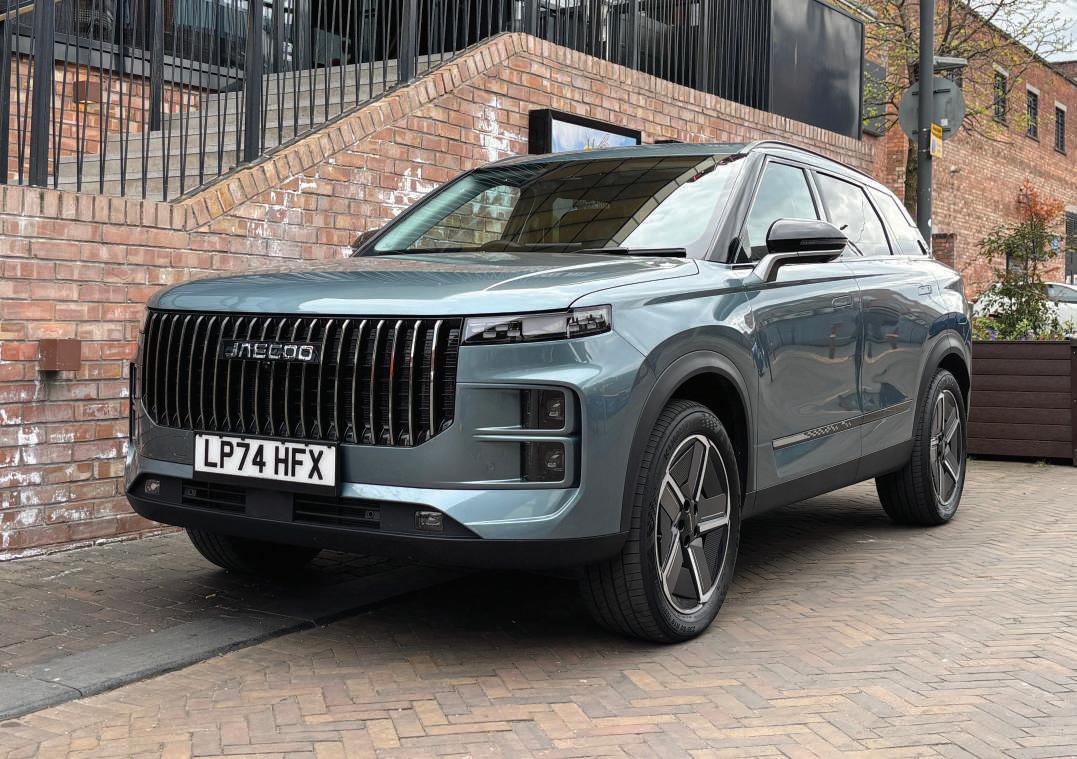

Company Car & Van grabbed some time with Chris Clayton, head of fleet at OMODA and JAECOO UK, to find out more about this ambitious company’s plans to grow its presence in this country
CC&V: OMODA and JAECOO are new car brands in the UK, but both are already making waves. Can you tell us a little but more about each, and what’s different between the two?
CHRIS CLAYTON: OMODA focuses on producing futuristic crossover SUVs that combine next-generation technology with distinctive design, emphasising sustainability and accessibility. The OMODA name is derived from the letter ‘O’, representing oxygen, and ‘Moda’, meaning modern, reflecting the brand’s commitment to contemporary and dynamic automotive solutions.


Meanwhile, JAECOO’s entry into the UK market is part of a broader strategy to establish a significant presence in Europe and other regions, and the cars are designed to be a more rugged option.
The brand’s name combines the German word ‘Jäger’ (hunter) and the English word ‘cool’, reflecting its aim to produce stylish vehicles capable of both on- and off-road performance.
CC&V: You’ve just launched the OMODA 9 with the SHS model featuring a plug-in
hybrid drivetrain and the JAECOO 7 also comes as a plug-in. Will both brands continue to include PHEVs in their line-ups?
CC: Not everyone is ready for an EV, and we want to provide the next best thing, which is a choice of the best petrol, electric and plug-in hybrid technology. Our Super Hybrid System, which has been developed using third-generation hybrid technology from our parent company, Chery Group, specifically meets the requirements of the UK market.
The SHS’s combination of a 1.5-litre turbocharged petrol engine, hybrid transmission with integrated electric motor and high-density lithium-iron battery pack, makes it ideally suited for both OMODA and JAECOO vehicles now and in the future.
CC&V: SMEs are slowly transitioning to electric vehicles, aided by low taxation, longer driving ranges and more public chargers. Currently there is just one EV
across the two brands, which is the OMODA E5. Will you be launching any electric vehicles in the next 12 months?
CC: The JAECOO 5 will launch in the UK this summer, and the range will include an all-electric version – the JAECOO E5 – with deliveries starting in August. A compact off-roader, the JAECOO E5 will offer a driving range of up to 250 miles and will be a compelling alternative to the petrol-powered JAECOO 5. The EV’s 61 kWh battery pack has been engineered for the ultimate combination of range, performance and cost, alongside durability and sustainability.
In the second half of 2026, we will introduce the OMODA 3 small SUV to the UK, which will be offered as a fully electric model alongside an SHS option. Full details about the electric powertrain will be revealed in due course.
CC&V: Your dealer network is growing rapidly. Do you have any corporate specialist sites, and are your dealerships set up to support fleet customers?
CC: We now have more than 70 dealerships, all of which are dual-branded and have a dedicated aftersales department. Each of our dealers is responsible for driving their own fleet leasing sales in their local areas, using a new white-label contract hire proposition provided by Arval. They are fully supported by our dedicated fleet team, which has grown from four people to 10 during 2025 – and we expect to add more resources in the coming months.
We’ll support our dealers every step of the way – whether it’s through a virtual account manager or one of the team accompanying them to meet a potential client. I want the network to really get on board with our PCH and BCH offerings.
CC&V: Is the fleet sector an important one to OMODA and JAECOO, and where would you like to see your brands positioned in the corporate sector in two years time?
CC: The fleet and business market are extremely important to OMODA and JAECOO, and both brands spent a lot of time prior to launch establishing their fleet operations. We see lots of opportunities in the sector, especially with our competitive pricing and the high specification levels across models in both brands. From launch, the JAECOO 7 SHS performed above expectations in a multitude of fleet channels, and we hope the newly launched OMODA 9 SHS will have a similar impact.
Over the next 24 months, we will continue to expand our dealer network and broaden the product ranges across both OMODA and JAECOO brands.
This strategic growth will support our full establishment in the corporate sector, offering drivers the quality, safety and technology they would expect to see in a premium brand – while delivering exceptional value for money and a wide range of options to suit employees at every level.
For more information, visit our websites: omodaauto.co.uk and jaecoo.co.uk or the global website www.omodajaecoo.com


OMODA...
is committed to design, intelligence and sustainable responsibility, bringing cutting-edge design and futuristic technology to young Generation Z users, offering them stylish vehicles ahead of their time. In the name OMODA, the “O” stands for life and vitality, a symbol of the essential element of life, oxygen. “MODA” is derived from modern fashion trends, while representing a new global focus on a sustainable lifestyle, an embodiment of ecological greenery and avant-garde style.
OMODA is dedicated to embracing global consumers and creating a forward-looking brand for a spirited new generation of car buyers. This attitude is embodied in OMODA’s first model to arrive in the UK, the OMODA 5.

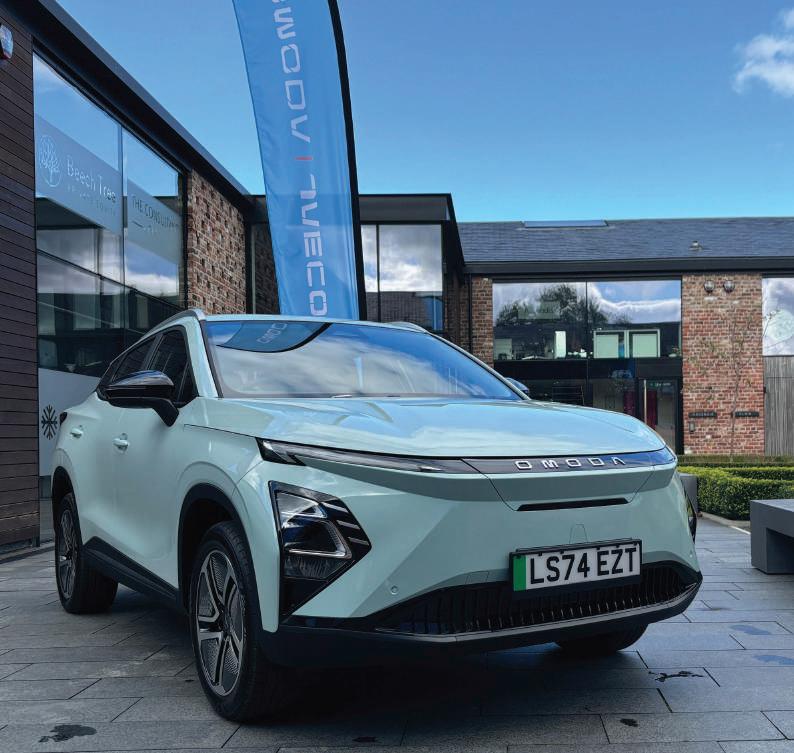
JAECOO...
A brand-new off-road brand arriving in Europe for the first time, the name JAECOO is inspired by a fusion of “Jäger” (meaning “hunter”) and “cool.” This melding of cultures captures both off-road and urban environments. With more than a decade of experience gained from a joint venture with the world’s most established off-road manufacturer, JAECOO was created to be “from classic, beyond classic”, dedicated to innovation, taking on the urban off-road environment with exceptional performance, world-class safety features and forwardthinking, intelligent technologies. JAECOO blends the experience and craftsmanship of teams from across the world, with the aim of establishing a new standard for urban off-roaders. Combined, OMODA&JAECOO is the fastest growing global automotive brand, with 400,000 cumulative sales to date.
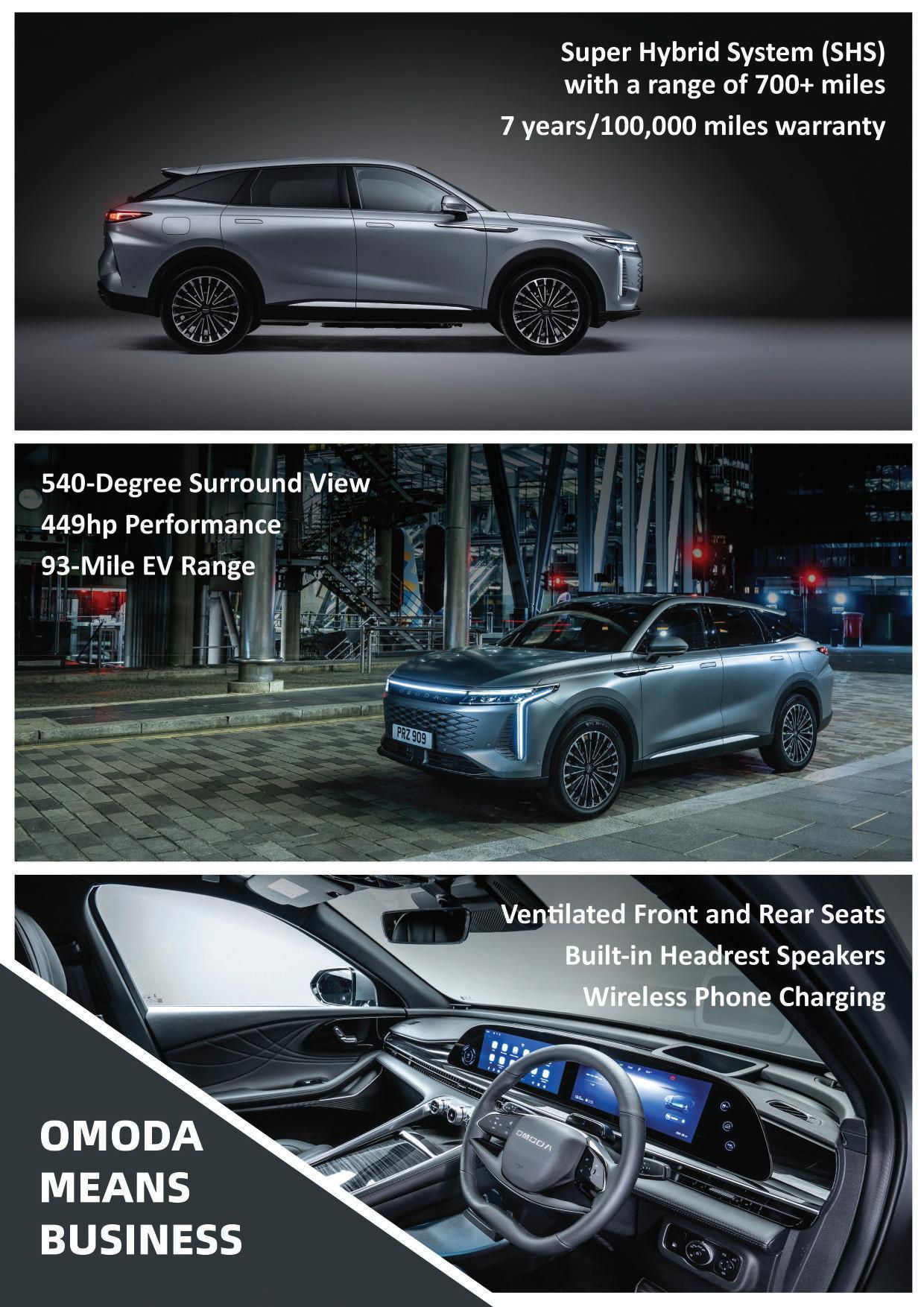

THE reigning Company Car & Van Car of the Year is the Peugeot E-3008. The Vauxhall Grandland Electric is built on the same platform, so it’s no surprise it’s a pretty good car, too. After a week traversing the roads of the north west, we’re pleased to say that Vauxhall’s produced an excellent electric car as well, one that ticks almost all the boxes –and it’s electric to boot.
Battery, range and charging
Currently there’s just one battery size available 73kWh packing a range of 325 miles, with a larger 98kWh battery coming later in 2025 which will increase the range to 435 miles. Claimed efficiency is 3.6 mi/kWh, with a maximum charge speed of 160kW allowing a 20-80% charge in 20 minutes. We’ve just had new ROLEC EVO 7kWh charger fitted https://www.rolecserv.com/ ev-products/evo which will replenish the Grandland’s battery from 0-100% in six hours 45 minutes. A heat pump comes as standard. Output is 210bhp with 345Nm. Top speed is 109mph and 0-62mph takes 9 seconds. Drive in Sport Mode and it does feel quicker.
Specs
Vauxhall is offering three levels of electric Grandland. Entry level Design features a 10” touchscreen, 10” digital instrument cluster, adaptive cruise control, dual zone climate control and rear parking sensors. Stepping up to GS adds a larger 16” touchscreen, a wireless phone charger, a power boot, a reversing camera, adaptive LED headlights, diamond cut alloys and upgraded upholstery.
We were driving the range-topping Ultimate which includes a panoramic sunroof, 20” alloys, a 360 degree camera, tinted rear windows, a head-up display and Intelli-Drive 2.0 which includes semi-automated lane change assist, lane positioning assist, blind spot detection, rear cross traffic alert and adaptive cruise control with stop and go.
Exterior
It’s an SUV but Vauxhall has managed to lift it somewhat with features such as the Intellilux Pixel HD with 3D illuminated vizor which comes on GS and above.
Interior
Inside our cabin was a black/grey/chrome colour scheme and it’s all nicely realised. The seats for example have a vertical silver line down the middle, the centre binnacle is finished in brushed chrome and the roof headlining is jet black. Quality is very good with some nice finishes on the dashboard front, top, doors and centre armrest.
There are cheaper plastics lower down, on the door pockets and glove box front but they look and feel built to last and with prices


starting at just £38,500 we can see why Vauxhall have used these.
Vauxhall’s latest infotainment system is very easy to use with sharp graphics and clear menus. Larger icons on the screen allow you to access car, home and media quickly with a useful proper volume knob and separate climate controls located underneath. Connecting wirelessly to Apple CarPlay was quick and easy with the Focal premium hi-fi sound system of 10 speakers and subwoofer a highlight.
A large electric SUV isn’t going to be the stuff of dreams to drive and the Grandland is no different. Weighing in at 2.1 tonnes means that you can feel the car’s weight, especially when driving over poor road surfaces. However, thanks to firm suspension and pliable shock absorbers, the rides pretty good and actually enjoyable when you get onto a winding road with sharp bends.
Choosing from Eco, Normal or Sport driving modes allows you to tailor the steering and power, with Eco pulling back on the lightness of the steering wheel and dulling performance. Normal and Sport release more oomph especially when you accelerate from 20-50mph.
We tried all three modes and felt that Normal is a good way to drive in moving traffic, with Eco better on the motorway. There are three levels of brake regeneration. Level 3 is the highest and this adds some heft to the accelerator pedal and slows you down quickest, but it’s not so heavy that you can’t drive with it at this setting all the time. We’d say it’s well balanced and definitely adds some miles to the battery range, without giving you a tiring heavy right foot feeling.
We drove around 400 miles on a mix of all roads, and the Grandland managed to give us almost a one mile driven to one mile ratio, which is always good news. We ended our week with a 3.8mile/kWh return, which is

higher than Vauxhalls claimed. Result. Whilst it’s not an exciting car to drive per se, it comes with a nice sense of calm and I never felt anything other than relaxed on board. I’d argue that it’s one of the nicest EVs I’ve had all year, and this is definitely helped by the 330-mile driving range. There’s little in the way of range anxiety here.
There’s a commanding SUV-style driving position with a decent view forward, which makes it easy to place on the road. On the motorway, it’s very refined with low levels of wind noise. This is clearly a car designed for covering long distances. It would definitely be an easy electric car to live with.
With prices starting from £38,500 it’s priced below the majority of its competition. It looks good inside and out. Driving range and charging speeds are very good. It’s a comfortable, spacious family car offering decent levels of equipment. At just 3% BIK company car drivers will be attracted.
It doesn’t offer much driving excitement. There are some cheap plastics used in the cabin. Other electric SUVs are more fun.
Others have damned the Grandland Electric with faint praise by saying it’s not much fun, but they are missing the point. Customers want a large, practical SUV that comes well equipped with enough space on board for five and their luggage. The Grandland Electric offers this in spades – with a 300mile range. Priced right and doesn’t offer an over-complicated cabin. For company car drivers who need a five-door electric SUV, it’s an incredibly attractive proposition. Choose a GS and you won’t go far wrong
CC&V RATING: N N N N N

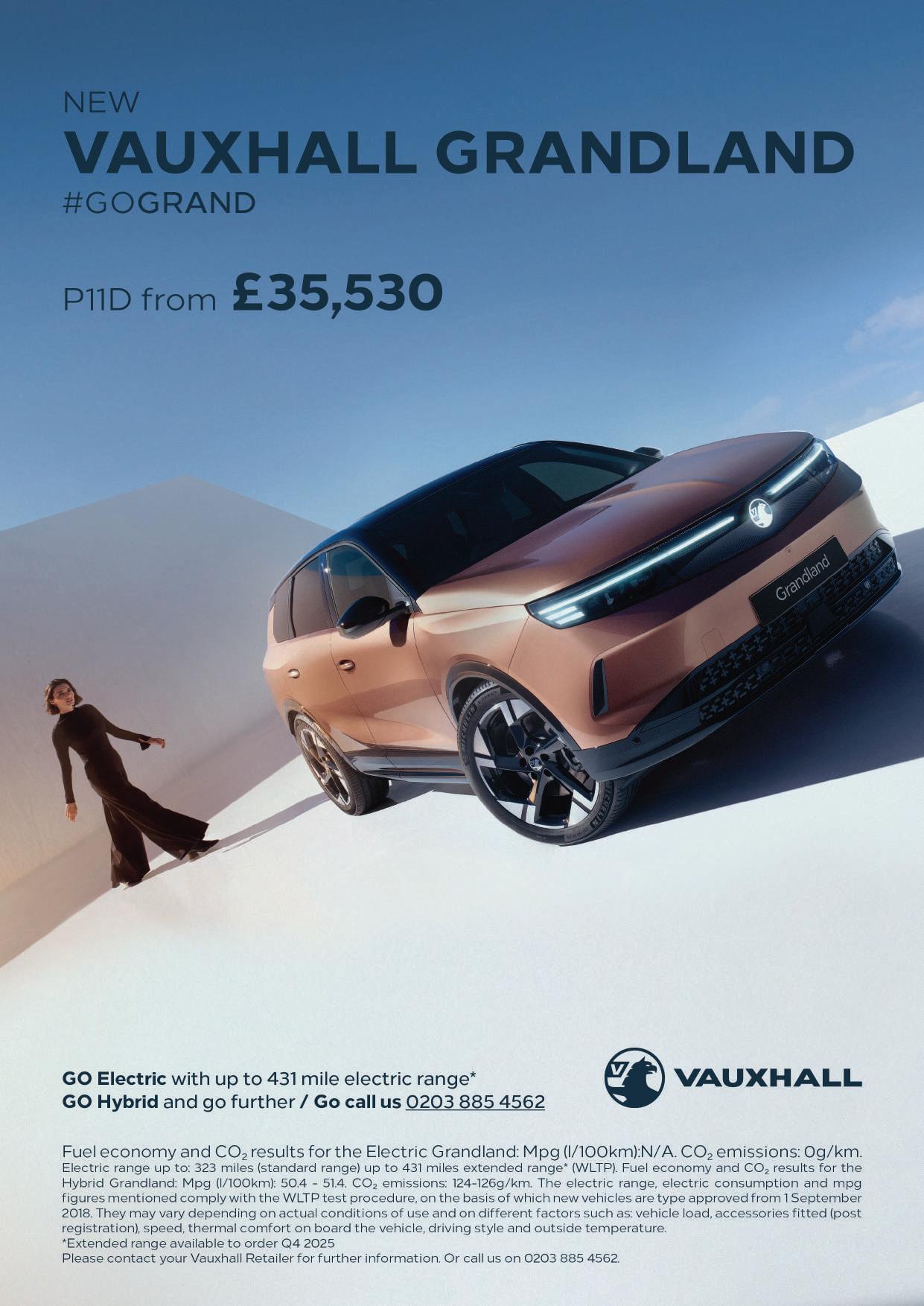
MG has been working hard to develop its product range, with the electric MG4 really shaking up the EV sector.
Now MG is hoping to perform the same trick with its best-selling HS, which has accounted for 27% of its global sales since it was launched in 2019. The all-new version has just landed and we took to the streets of Bedfordshire to see what the plug-in was like.
Exterior
This is where the new HS really shines. Gone is the pre-gym 2019 version, replaced by a much fitter and slender-looking five door SUV that oozes charm.
Slim LED corner headlights adorn the front with the large MG logo sitting on the bonnet front. The side profile is very F-Pace with narrow windows and sleek lines.
Interior
Here too the latest HS is a big step up from what came before. The quality of fixtures and fittings is vastly improved. Our dash top drumming test produced a satisfying thud and the dual screens add a touch of class.
Perhaps lower down the door pockets and centre binnacle edges lack a bit of quality, but overall it’s impressive.
Engine choice, electric range and performance
Petrol, hybrid and plug-in hybrid are available. The petrol 1.5T has either a six-speed manual or seven-speed DCT gearbox, the plug-in an auto two-speed box.
We were testing the best company car option, which is the PHEV. It’s powered by a 67kW generator, 154kW motor and a 24.7kWh battery that’s good for a pure electric range of 75 miles. Acceleration from 0-62mph takes just 6.9 seconds.
Model choice
Two familiar MG specs are available, SE or Trophy, and both are improvements on the old model. There’s a 12.3” Virtual Driver Display, 12.3” infotainment screen, wireless charging, 19” alloys, electric memory function seats, wireless charging and SatNav with live services on all versions.
Prices
SE manual petrol costs from £24,995, the SE auto £26,495, Trophy manual £27,495 and Trophy auto £27,995. The plug-in SE costs £31,495 and Trophy £33,995.
Driving
The biggest compliment we can pay the
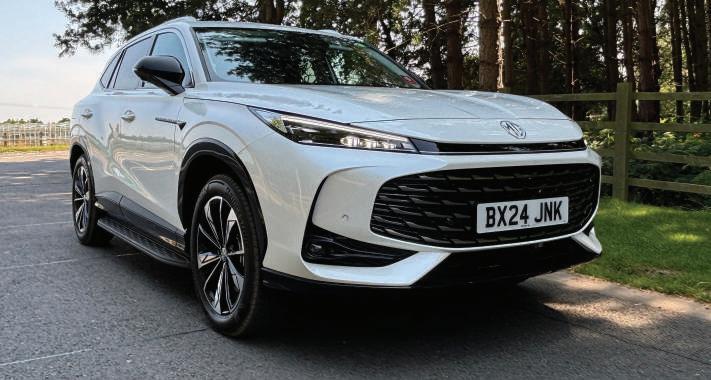

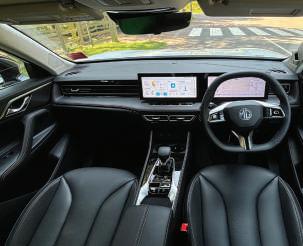

plug-in HS is that it’s pretty damn good to drive. It’s quick and nimble, offering plenty of steering wheel feedback on tight turns or bends. The battery weight remains well hidden, even over poor road surfaces, and driver comfort and visibility is excellent.
The gear lever and electric parking brake are between the front seats and changing gear is very easy compared to many SUVs that now feature quirky steering wheel gear changes or toggles located elsewhere.
On the motorway the cabin remains calm and quiet with little wind or road noise getting through. We set cruise control via the steering wheel buttons – a tad fiddly to be fair – then sat back and relaxed.
Front seat passengers get good head and legroom although the electric seat adjustment buttons are a tad flimsy. Rear room is good thanks to the flat-ish floor.
The 12.3” screen is large enough and the operating system quick enough to keep you happy. You simply scroll left or right to choose each input such as SatNav, Radio and Climate with both Apple CarPlay and Android Auto also displayed for quick access. Our only gripe is that the icons for CarPlay and Android Auto are located on the left hand side of the screen so are a little bit of a reach for the

driver. You’ll also find switches to shift from hybrid to electric driving and to turn off safety features such as driver monitoring. MG is not alone in making this available but to our mind, drivers are capable of concentrating on the job at hand without being told every few seconds to look straight ahead.
Great looking, well equipped, spacious and comfortable plug-in hybrid. Low BIK and electric range of 75 miles makes it highly appealing for company car drivers. Price wise the plug-in HS is cheaper to buy than most rivals’ C-sector SUV offerings.
The infotainment is not the most logical to access. The steering wheel-mounted switches for the cruise control and media are a little fiddly. All-around quality is better than before, but it’s still not as good as other more expensive offerings.
The latest HS is light years ahead of its predecessors. It’s larger, better equipped, features more safety, is better built and looks far better than the original. Its 75-mile pure electric range means it is going to be vying for your attention in the C SUV sector, especially as it’s priced where rivals’ B SUVs sit. Still some quibbles on switchgear and the touchscreen but other than that, it’s another winner for MG. Bound to attract a broader range of customers in the SME fleet sector .
CC&V RATING: N N N N

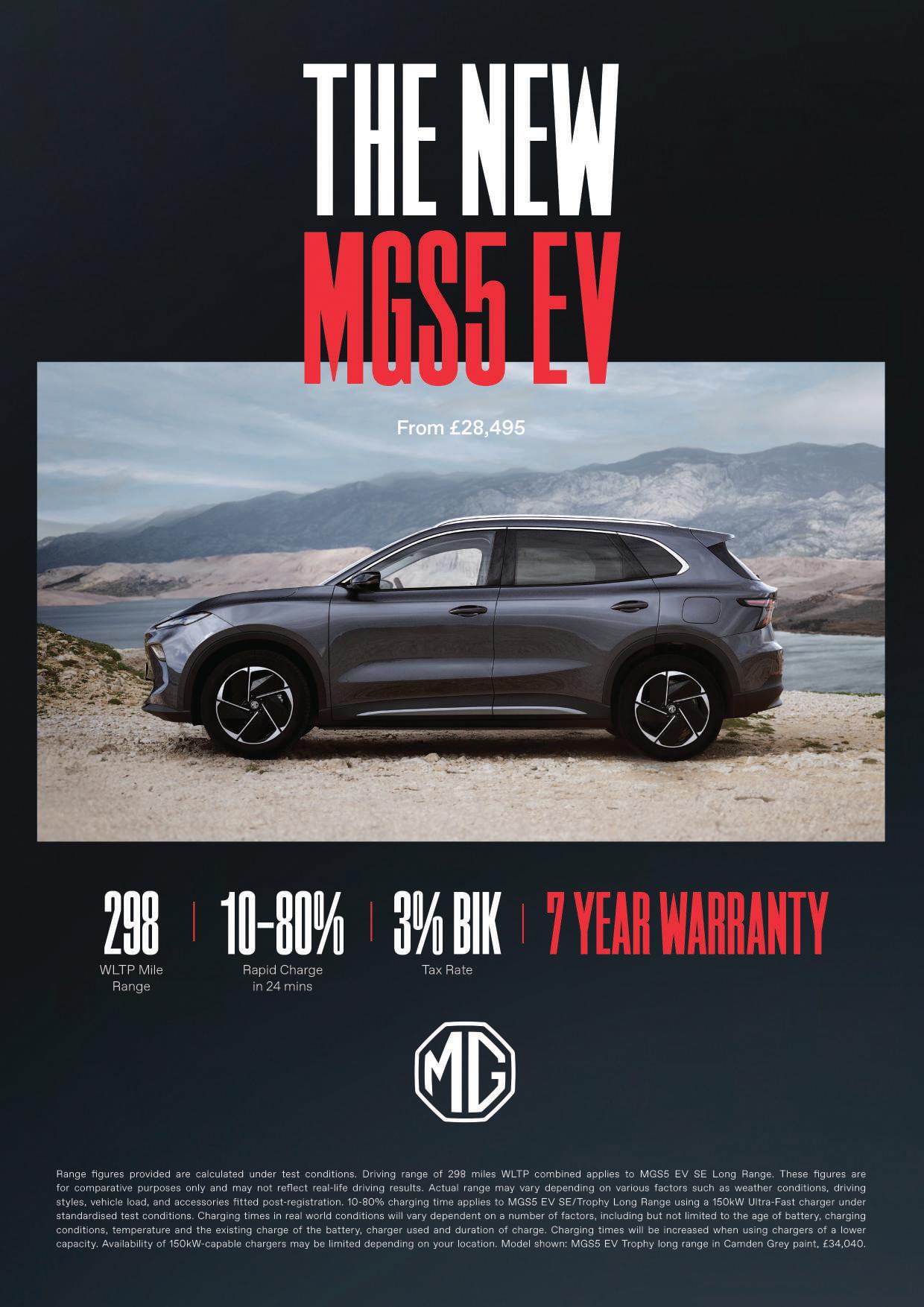
We explain why the Peugeot E-3008 is our Company Car & Van Car of the Year.
WELCOME to the E-3008, Peugeot’s new EV which takes not only a swipe at established electric leaders such as the Tesla Model Y, but at pretty much everyone else’s mid-sized electric car as well. We spent a day assessing its merits and here’s how we got on.
What is it?
The Peugeot E-3008 comprises a permanent magnet synchronous motor operating in tandem with an electric gearbox to deliver more power, efficiency and torque, powered by a 400V lithium-ion battery. In efficiency terms it is the range that’s most improved, with up to 422 miles now available.
Charging, battery and range
The E-3008 is capable of charging speeds up to 160kW, enabling standard range battery to be recharged from 20% to 80% in 20 minutes. Plug-in at home and on a 7.4kWh charger and charging takes eight hours from 20%-100%, or six hours from 20%-80%.
There are two batteries: the 73kWh has a range of 326 miles and the larger 98kWh battery offering up to 422 miles of range. Both are single motor. A Dual Motor AWD will follow which will be fitted with the 73kWh battery and come with a 326-mile range.
Trim choice and power options
There are two trim levels, Allure and GT, both offered with the 210 Single Motor powertrain. Two more electric powertrains will join the range next year. The singlemotor versions offer 345Nm/157kW or 345Nm/170kW.
Exterior
Peugeots have been getting more handsome of late and the E-3008 is no different, introducing a fastback profile to the range for the first time. There’s a redesigned
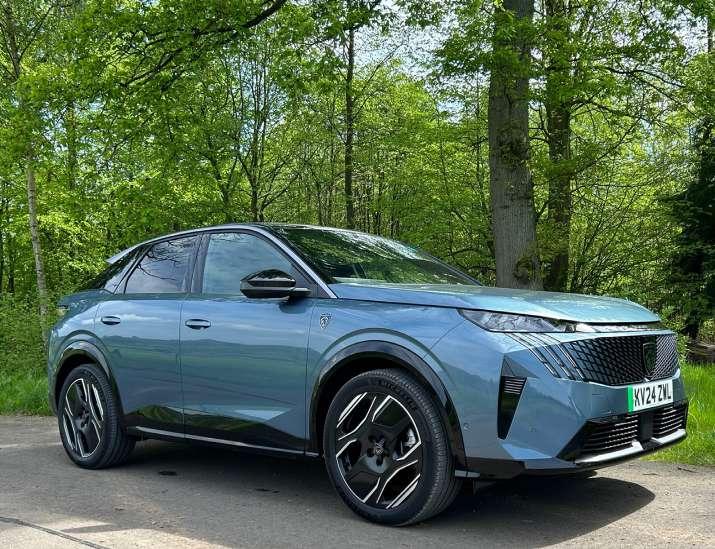
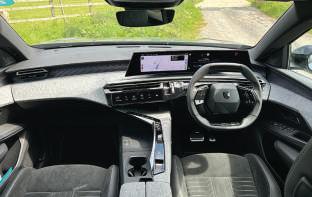
front end with slim LED headlamps, lion’s claw vertical light strips and a large Peugeot logo in the centre of the diamond-shaped front grille. Both versions also come with Peugeot-emblemed wheels, an aerodynamic profile ending with the sloping fastback rear, a narrow rear light band and a floating spoiler.
Interior
The i-Cockpit is still there but it’s had a major facelift. It’s now the ‘Panoramic’ i-Cockpit and features a floating, curved 21” HD panoramic screen that combines the head-up display with the central touchscreen. Slightly curved towards the driver, the screen looks fantastic and most functions are accessed through it.
Quality wise it’s the finest Peugeot cabin yet and well specced, with dual zone climate control, heated and ventilated seats, a heated steering wheel as well as tinted privacy glass for the rear doors, a reversing camera, 11kW on board charger and three 12V sockets, among a list of items too long to publish.
Top speed is 105mph with a 0-62mph time of 8.8 seconds. WLTP Combined range for our test car’s smaller 73kWh battery is 326 miles. With zero CO2 emissions BIK is a tempting 2%. WLTP numbers suggest the E-3008 can hit 4.6 miles per kilowatt-hour and on our cross country test we were just above four miles per kWh, so it is doable.
No shocks, very typical of its kind. The all-new platform incorporates new front and rear axles and the single layer battery which sits low between the wheels. In theory this should help the ride, but as we’ve discovered it’s a near impossible trick to pull off. We’d point the blame here firmly at the new
heavier battery, as the E-3008 doesn’t offer up much in the way of driving fun. Longer range = heavier battery = fidgety ride.
On the plus side, the steering is pretty good and the E-3008 manages to feel agile over undulating roads and through tight turns with little or no body roll. The steering is quite light, which is a bonus for urban driving, and the on-board parking aids make tight spaces accessible.
The paddle-mounted brake regeneration is a really good addition as is the all-new Panoramic i-Cockpit.
On the motorway the adaptive cruise control with distance adjustment makes longer journeys stress free. It’s all carried out within a quiet cabin aided by the acoustic windscreen, with the E-3008 scoring highly as a people-carrying motorway cruiser.
Pros
You won’t find a better looking electric car. A choice of two large batteries means a class-leading range. On-trend tech and safety is a given. BIK of 3%
Cons
The ride is only average, but that’s standard on large battery electric SUVs
In a competitive electric class, the E-3008 may look on paper very similar to its rivals, but at present it hold one big advantage: driving range. A company car driver or fleet manager is most likely to want a long range on their EV over and above anything else, and on that count alone, the E-3008, with its class-leading battery range, is a resounding success.
Add in catwalk good looks and for CC&V, it’s our Car of the Year.
CC&V RATING: N N N N N

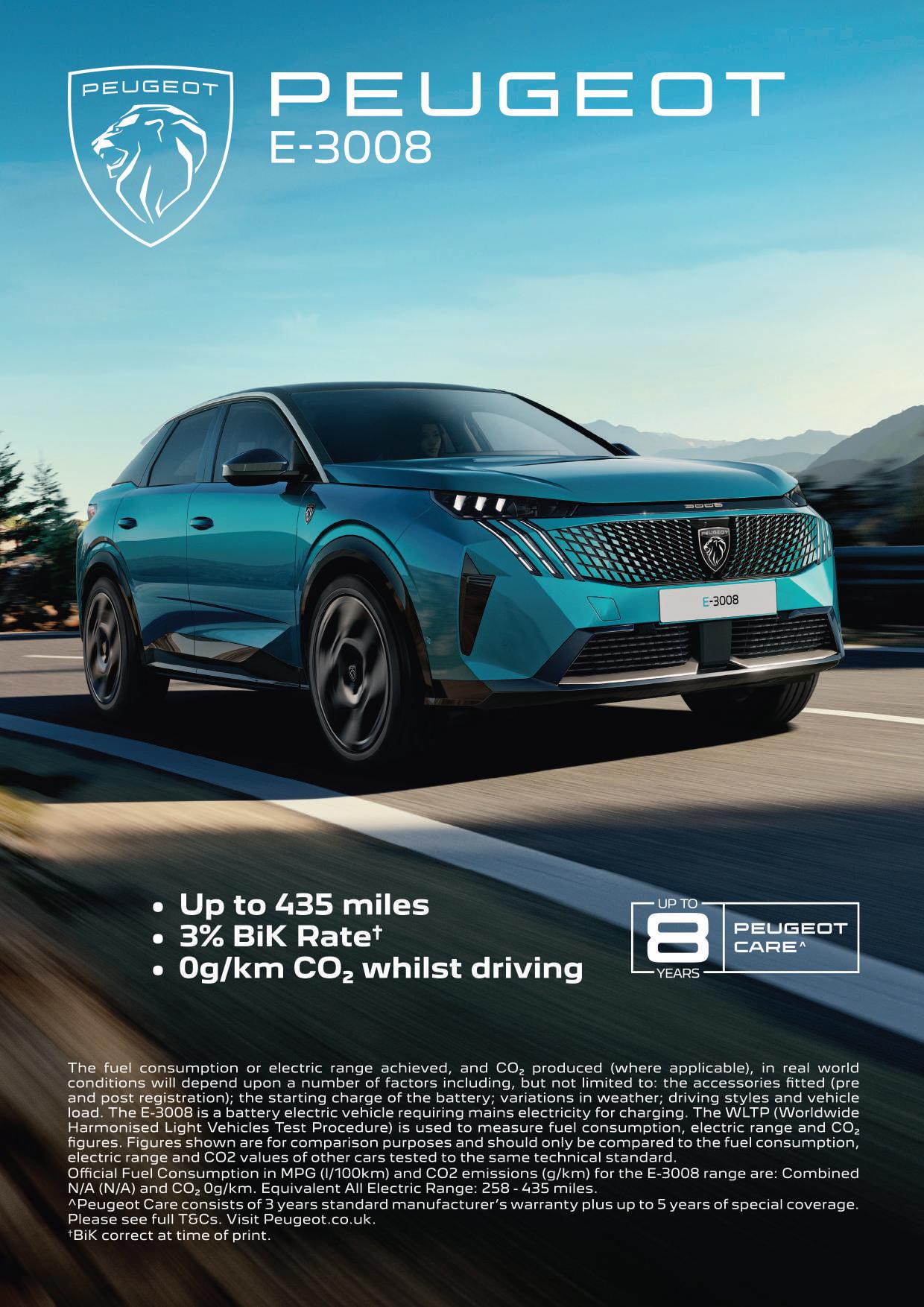
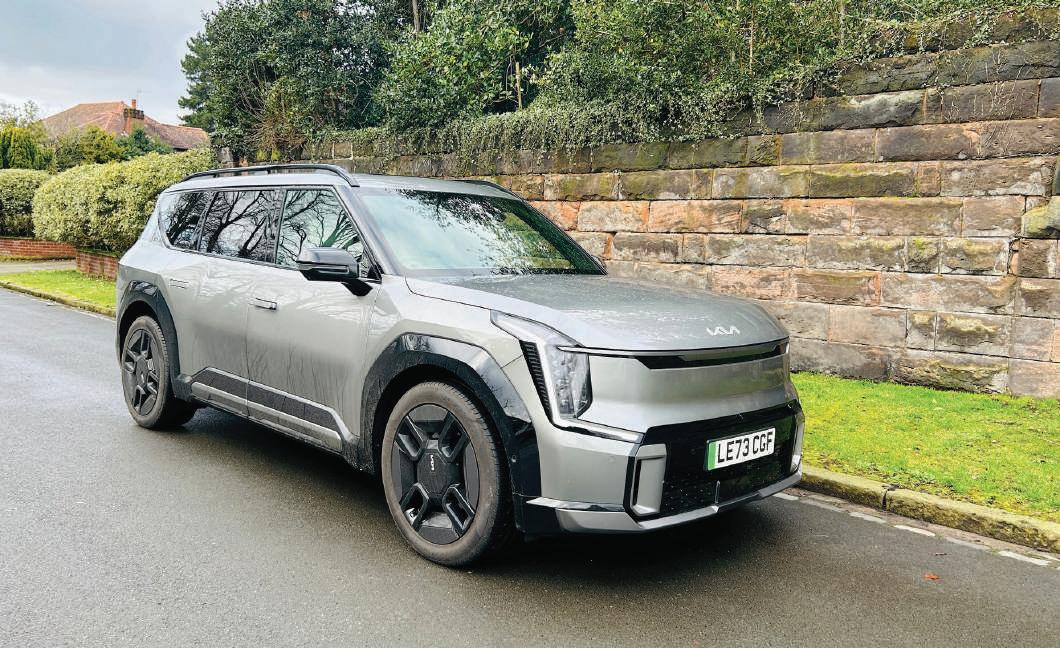
Kia can do no wrong at the moment, and the EV9 adds more lustre to the brand. Andrew Walker likes what he sees...

What is it?
The EV9 is Kia’s flagship electric SUV and at 5 metres long, it makes a big impression.
Battery and range
A single 99.8kWh battery is offered, with 96kWh of that usable. Large batteries equal longer range, so expect up to 359 miles between charges with the bonus of an on-board heat pump, too.
Model choice
Three versions are available. Entry level Air cost’s from £64,995 and comes with rear-wheel drive, 200bhp and 350Nm. Or there’s a dual-motor four-wheel drive version, offered in GT-Line or GT-Line S trim, with 380bhp and 700Nm of torque.
Equipment
All versions come with a triple-screen dashboard layout, twin 12.3” displays, a 5.3” climate-control panel in between, six USB-C sockets two per row, front and rear parking sensors, a powered tailgate, second-row window blinds and raft of safety features including smart cruise control, drive mode terrain mode select, downhill brake control, ABS, ESC, DBC, HAC, Trailer Stability Assist and Lane Keep Assist.
Air features 19” alloys, 8-speaker audio, LED headlights, power adjustable front seats and gloss-black exterior trim and is a 7-seater. GT-Line is also a 7-seater and retails at £73,425 adding 21” alloys, a massage drivers seat, two-tone upholstery, electric steering wheel adjustment and
adaptive beam headlights. Range-topping GT-Line S comes with either a 6 or 7-seat configuration, but will set you back £76,025 as a 7-seater. It does have front and second row sunroofs, a 14-speaker sound system and a heads-up-display,though.
Hard to miss really. Rectangular, chunky, long with vertical corner LED headlights, a narrow front bonnet line, rear roof spoiler, high corner tail lights and black roof rails.
The quality is excellent with the dash seemingly hewn from solid stone. The seats are incredibly comfortable, especially the pillow-like front head rests.
The large infotainment screen is clear and the Kia set-up and screen icons will be familiar to existing Kia customers; all very logical. As with most new cars you have to access the screen to turn off lane departure and speed limit warning every time you re-start the car, which is frustrating. Otherwise, the system is easy to work and to use. Wireless Apple CarPlay and a wireless charging pad make connecting your iPhone a doddle. There’s a touch-sensitive panel beneath the screen, with options including Home, Set Up, Media, Search and Map, but it requires a proper hard prod to register your input choice, which isn’t as easy as it could be.
The cabin is huge and most importantly
both the rear 60:40 seats slide back and forth which increases the third row legroom. The seats are very heavy, with the rear 50:50 row remote folding flat into the floor. You get a second row armrest with cupholder, roof located rear climate controls, front, second and third row overhead LED lights and 2 USB’s per row too, plus there’s two 12v sockets and a luggage compartment 3-pin socket. Under the boot floor there’s storage where you can tidily pack away the rear parcel shelf, with a net and hooks as well.
Up front there’s a 52-litre frunk to store your charging cable, easily opened via the key fob. Front passengers benefit from a centre twin cupholder, large glove box and door pockets. In 7-seat mode the boot offers 333 litres of space and a massive 2,318 litres if you fold the rear seats down.
Range
We were testing the dual-motor version with a combined range of 313 miles. Kia has a number of battery saving aids to help you get the most from your EV9. First there’s driving modes: Eco, Normal and Sport. Each does what it says on the packet.
Which brings us to the i-Pedal. Alongside the driving modes, the EV9 has several levels of regeneration: Zero, 1, 2, 3, and then i-Pedal. Being someone who wants to get as much range out of my electric cars battery as possible, we spent our week driving almost always in Eco mode. If you select the i-Pedal, this offers the highest level of regeneration and reduces your need for the brake, perfect for the city. Continued on page 32

Continued from page 30
Venture onto 40mph roads and Level 2 or 3 gives you a bit more zip, while on the motorway, Level 3 or Zero, allows you to drive the EV6 unhindered. iPedal on the motorway really isn’t intrusive at all.
When battery range isn’t your paramount concern, turning off the regeneration and driving in Sport mode opens up the performance one associates with electric cars, and the EV9’s a revelation! Its ability to iron out the shakes associated with large battery EVs also shines through. Kia has done a great job of masking the battery’s effects on the ride and it handles nicely.
As most EV drivers charge at home, we’ll begin with a 7kWh charging time of 9 hours 5 minutes. Away from your charger a 50kW fast charge will take 1h 23 minutes, or on a super-fast 350kW charger, just 24!
The EV9, thanks to its amazing torque and 5.3 second 0-62mph acceleration, doesn’t feel large or heavy in a straight line. It’s focused on comfort and glides over the tarmac, with the huge battery incredibly well hidden even on the worst of UK road surfaces. This is quite something as the EV9 doesn’t feature air suspension nor any sort of adaptive dampers.
Driving on narrow tight roads with plenty of corners, you’ll notice the oversteer as you

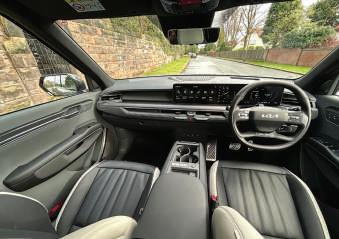
over compensate for its 5m length and 2.6 tonne weight. Shifts of direction may need some attention as the steering is very light for such a long vehicle. Over time you’ll realise that the EV9’s weak body control is actually a blessing in town and no hindrance at all on the motorway.
If you’re sat in the front the EV9 it doesn’t feel large either. When you glance back though you’ll appreciate it’s size and even though all-around visibility is decent, you’ll be glad of its parking aids when reversing. Those on board will have few complaints about head and legroom, even in row three as the EV9 feels bright and airy. We can’t think of a better car for a large family to take for a long journey.
The battery range in Kias and sister brand Hyundais is one of the best there is. What we mean by that is that if you want to drive at 70mph on a motorway, the EV9’s range won’t drop dramatically, something that definitely
can’t be said of other electric cars. For example, we took a trip to Liverpool and back which entailed around 60 miles of motorway driving and at motorway speeds, and we used 60 miles of range. With two on board and luggage, we drove in Eco mode at all times and also utilised the iPedal. We’d expect a range of between 250 – 280 miles without much trouble, an excellent return for an electric seven-seater.
Pros
Comfortable, spacious, well equipped, impressive range and charging times and for it’s size, surprisingly enjoyable to drive
Cons
Expensive. Long, it only just just fits into some parking spaces.
Kia’s EV6 is one of the best electric cars out there, so it’s no surprise that the EV9 is pretty good as well. Despite its size and weight, it handles like a smaller car, especially useful in town. Real world range is also excellent. The rear-wheel drive Air will cost you less and will go further. Light steering comes with a bit of oversteer and no models are cheap, but therre’s little out there that’s real competition
CC&V RATING: N N N N

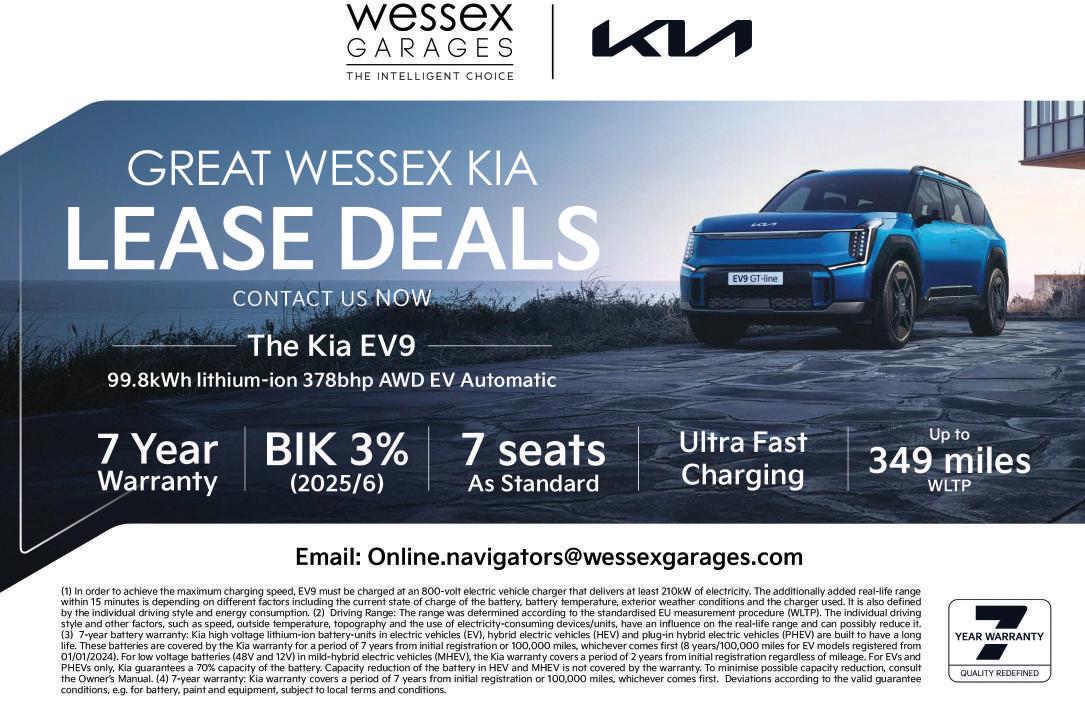
FAMILY-run dealer group Ron Brooks Motor Group has opened a new showroom representing the Chinese Chery brands in the heart of the East Midlands.
The firm has been appointed as an official retail partner of both Omoda and Jaecoo in Leicester.
The group is already partnered with both outfits in Derby and Mansfield but the new dealership represents its first venture into
neighbouring Leicester. The move forms part of a wider growth strategy, which will see the firm ‘grow meaningful relationships’ over the coming years.
Tom Slack, group manager, strategy & innovation at Ron Brooks Group, said: “We are committed to a new growth strategy over the coming years. Our aim is to grow meaningful relationships with selected brands at scale to navigate the future market in true a
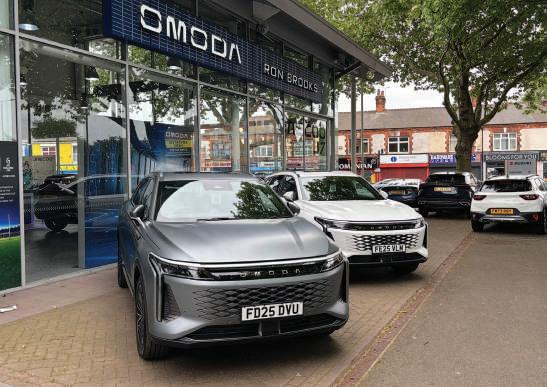

Founded in 1962, Ron Brooks Motor Group has now been supplying new and used vehicles to customers across the country for more than six decades, and is delighted to now represent Omoda and Jaecoo in Leicestershire, too
partnership. This strategy will be aided by our operational, geographical and customer focused excellence.
“It is a very exciting time for the business and our colleagues, and we are proud to offer ever more choice to our customers.”
Founded in 1962, Ron Brooks Motor Group has now been supplying new and used vehicles to customers across the country for more than six decades.
The firm now says that it will be taking all of that knowhow into its new venture, representing some of the newest brands on the UK market.
Slack added: “I am pleased we have secured the Leicestershire market area for Chery brands Omoda and Jaecoo.
“This is contiguous to our other territories with the brand in Derby and Mansfield in Nottinghamshire. We will open our site in the heart of Leicester in the coming months.
“We thank Chery, Omoda and Jaecoo for their continued trust and faith in the Ron Brooks business.
“Leicester is a new city for the group but builds on our 60-year history in Derbyshire and Nottinghamshire, elevating us to a true regional operator across the East Midlands.”
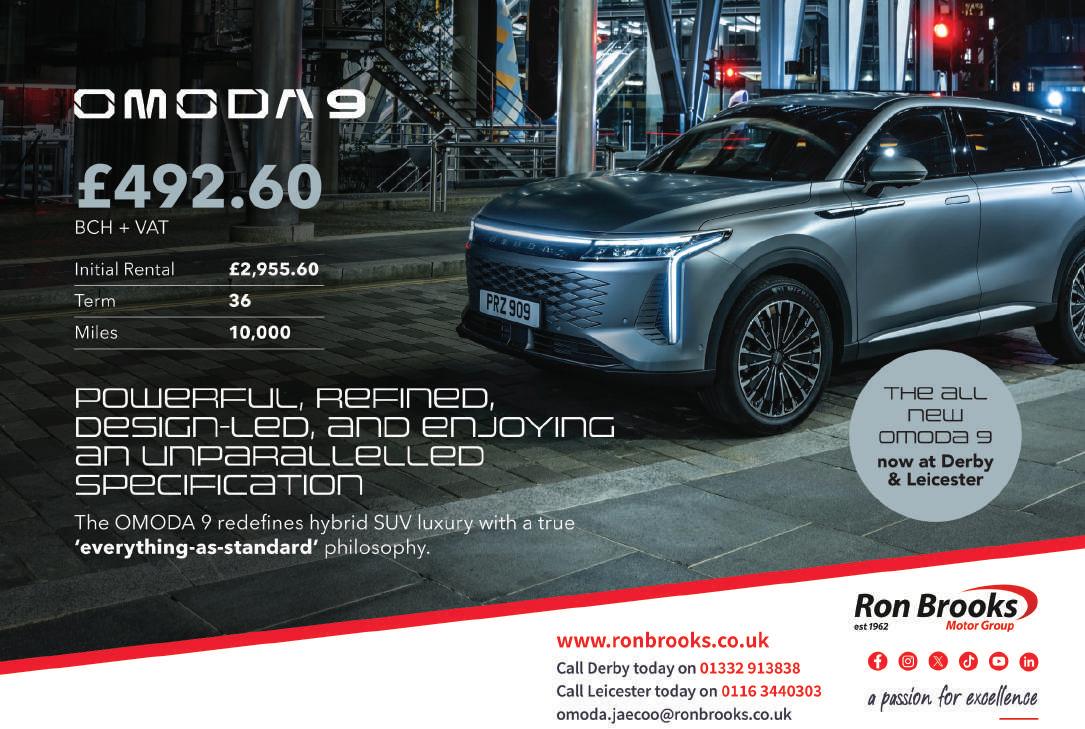
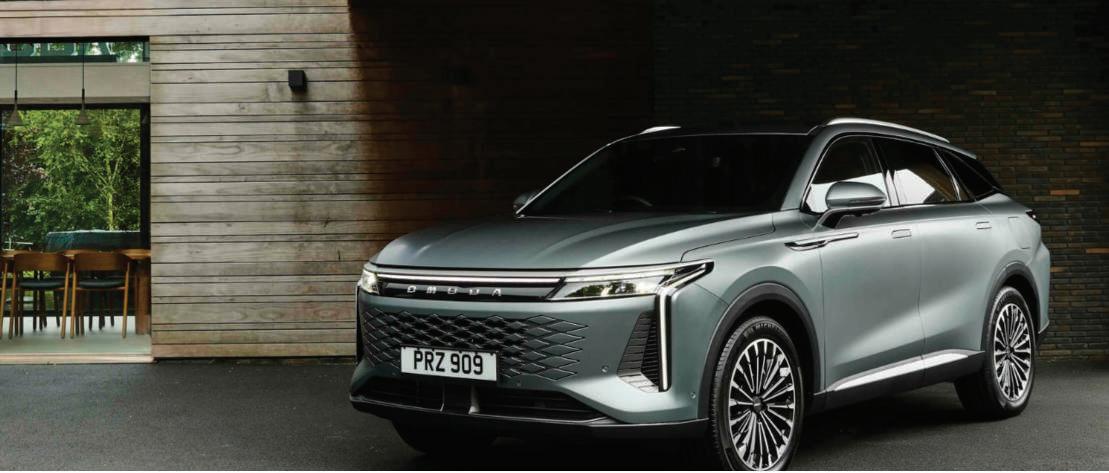
OMODA’s new flagship SUV – the OMODA 9 SHS – is already turning heads and causing a stir in the company car world. Combining advanced hybrid performance with refined design and quiet luxury, the all-wheel drive OMODA 9 SHS sets a new benchmark in the premium plug-in hybrid SUV segment.
Crucially, these attributes don’t come with the price tag you’d expect. Rather, this refined and luxurious SUV is priced from £44,990 OTR – considerably less than similar specc’d rivals.
For drivers that demand the ultimate performance, efficiency, technology and comfort, the OMODA 9 offers a complete package.
Praised for its comprehensive standard specification, the OMODA 9 SHS blends refined performance with intelligent technology and impressive efficiency. Its advanced self-charging hybrid system –which also offers plug-in capability – delivers a WLTP range of over 700 miles, including up to 93 miles in pure electric mode. CO₂ emissions are as low as 38 g/km, while total system output reaches 449 PS and 700 Nm of torque – enabling 0 to 62 mph in just 4.9 seconds.
Quiet, capable, and engineered for comfort, the OMODA 9 SHS features a three-speed Dedicated Hybrid Transmission, intelligent all-wheel drive and electromagnetic suspension. Cabin noise is reduced to just 45.8 dB at urban speeds thanks to acoustic glass and specially designed acoustic tyres.
Visually, the OMODA 9 SHS is defined by golden-ratio proportions, a wide-body stance, and a dramatic LED front signature that illuminates on approach – reinforcing its bold, confident character. Its design hides its body: passengers will appreciate the
4.77metres in length but it never feels like a large car to the driver.
With unique properties and structures, crystals embody distinct physical and energetic properties. The OMODA 9’s unique colour palette takes inspiration from the natural strength, beauty and energy of crystals, offering five distinctive shades.
Inside, the OMODA 9 SHS places comfort and technology at the heart of the driving experience. With an impressive 1.3m sunroof, the OMODA 9 lets the outside, in. Flooded with natural light, the interior space is much more welcoming and bright. With the ability to
“The OMODA 9 represents everything we stand for – intelligent engineering, elegant design and hybrid tech that fits with daily life“
open the roof half way, passengers can experience nature in comfort. A full length electric blind provides shade or privacy when desired.
Standard features include a 540-degree panoramic camera system, cabin air purification, heated and ventilated seats for four occupants, and a premium 14-speaker SONY surround sound system. The driver’s seat also has speakers built into the headrest, allowing the drive to take calls or listen to music in private, without disturbing the other occupants
A curved 24.6-inch HD display with a companion app, ambient lighting, electronically reclining rear seats and a plethora of cutting-edge features complete a
cabin that’s designed for quiet luxury.
Crafted from premium materials, the OMODA 9 interior is sculpted to inspire and impress. Complimenting the exterior, the cabin immerses passengers in quiet luxury and technology, to delight the senses.
The OMODA 9 redefines hybrid SUV luxury with a true ‘everything-as-standard’ philosophy.
Victor Zhang, UK Country Director, OMODA UK, commented: “Seeing the first OMODA 9 SHS vehicles reach customers – and hearing their reaction to their new vehicles – is a significant milestone. This model represents everything we stand for – intelligent engineering, elegant design and hybrid technology that fits seamlessly into daily life – without the premium price tag.
“Our SHS system, which also powers the best-selling JAECOO 7 SHS, proves that hybrid technology has evolved. The OMODA 9 SHS delivers electric-like performance, exceptional comfort and true ease of use. It’s the kind of car that offers more than just efficiency – it brings power, calm, and a real sense of quality to every journey.”
Offering the refinement, quality, technology and safety of a large premium SUV at the cost of a mid-size alternative, the OMODA 9 SHS is available now through OMODA & JAECOO UK’s expansive retailer network. It is priced from £44,990 OTR and includes a seven-year/100,000-mile warranty (whichever comes first), with unlimited mileage in the first three years, plus an eight-year battery warranty and RAC home start cover as standard.
OMODA UK’s growing nationwide network of 74 retailers is on hand to deliver exceptional customer service as well as a truly exceptional PHEV.
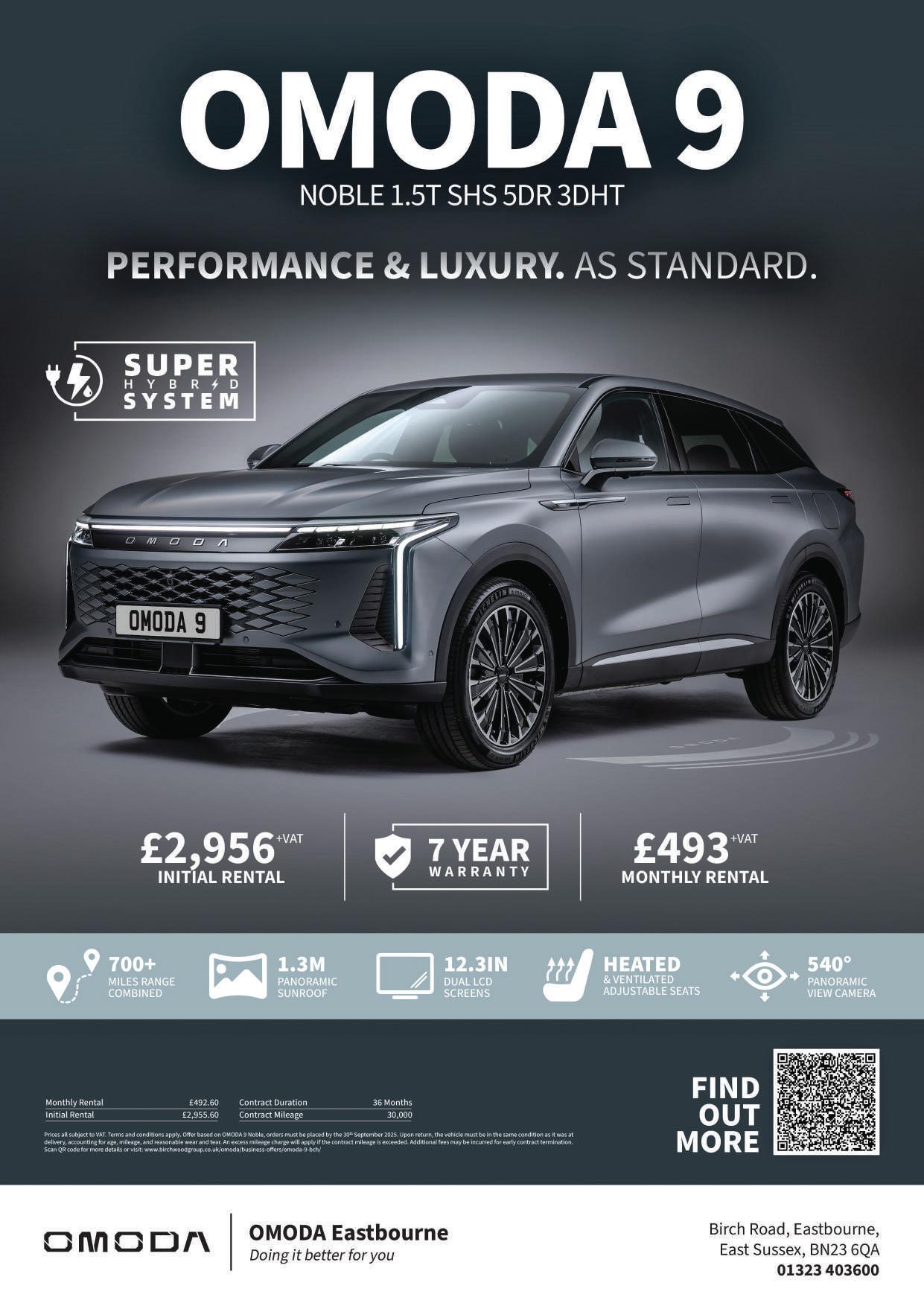
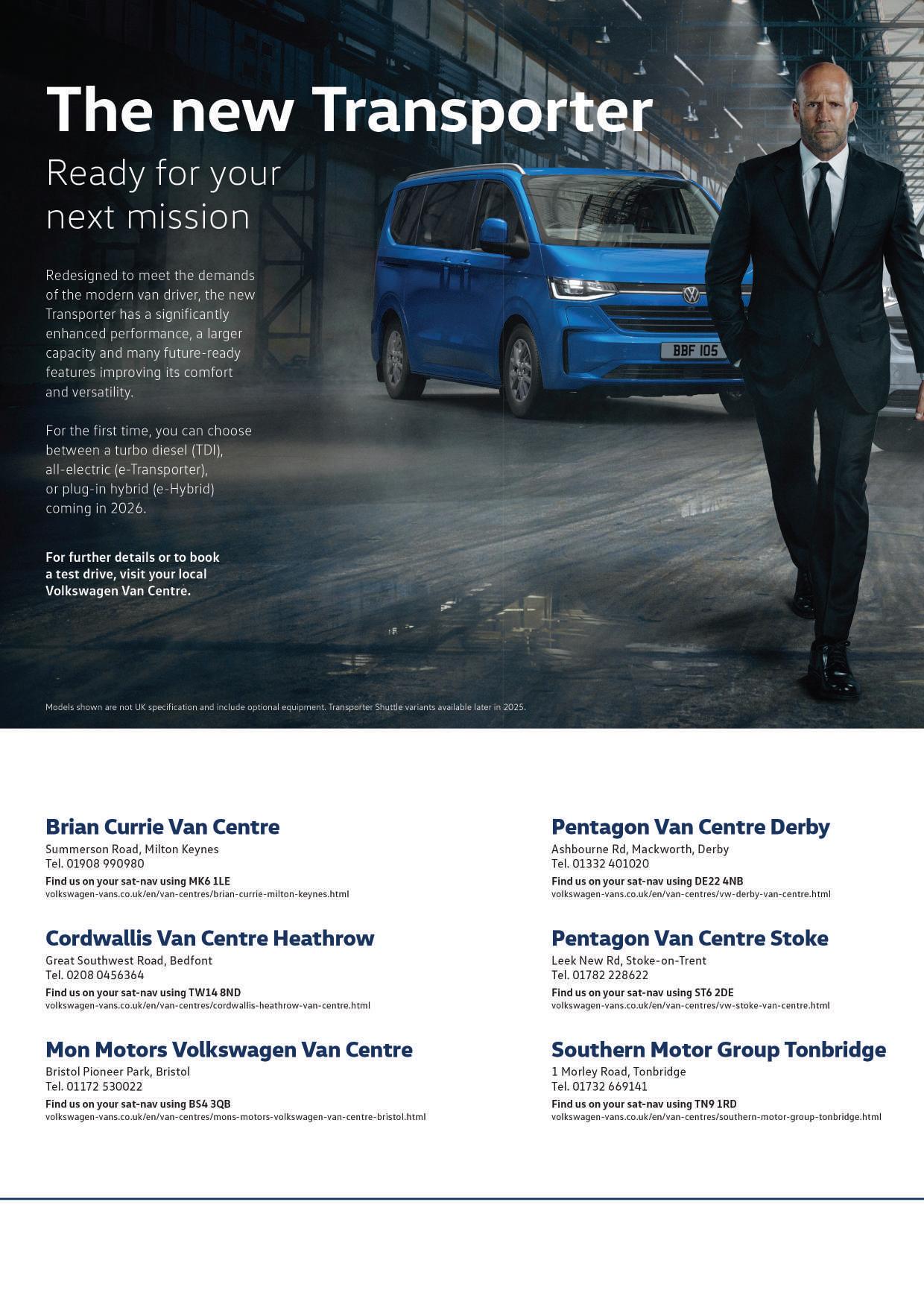




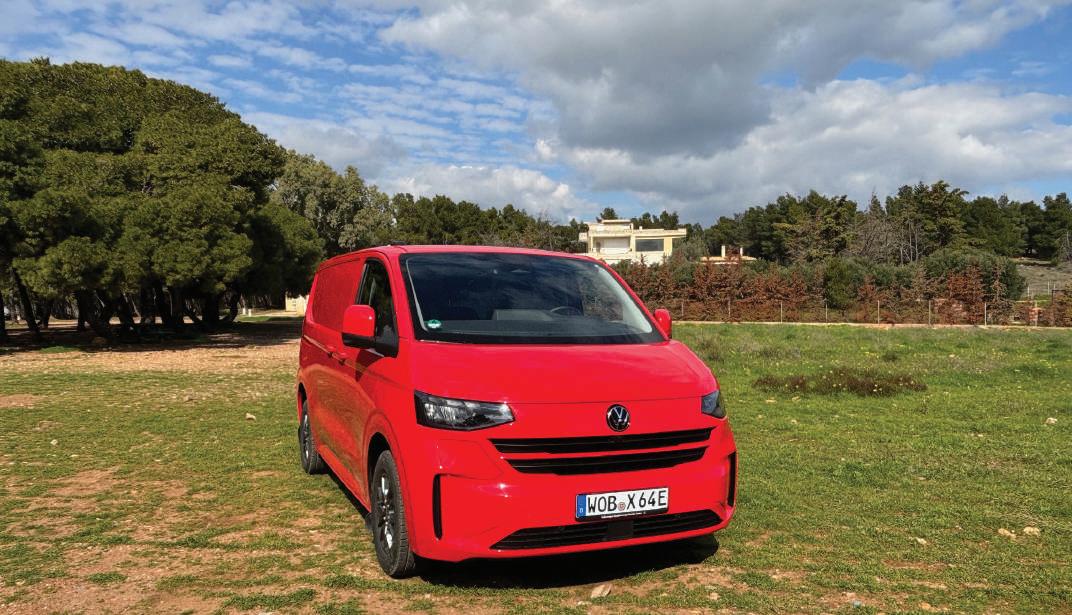
Volkswagen has launched the seventh generation Transporter van, this time based on the class-leading Ford Transit Custom. The Ford/VW strategic partnership has already delivered the Connect/Caddy and Ranger/Amarok, so this latest joint venture is hardly a surprise. Ford sells more Customs than Volkswagen does Transporters, but in a bid to reverse this Volkswagen has definitely come out fighting, with the all-new e-Transporter launching with a longer warranty and higher specs than the Ford van. We spent some time on the Athenian Coast putting the latest electric van to the test, and here’s what we found out.
THE seventh generation Transporter has an enlarged load or passenger compartment, a higher payload and increased efficiency. From launch there’s a Panel Van, with Kombi, Shuttle and Double-Cab variants following later this year. All models are available with turbodiesel, plug-in hybrid and electric drives, with the design and platform shared with Ford’s Transit Custom.
Looks-wise the front and nose are the main visual changes that VW has made to Ford’s version. The front grille takes its influence from the T5. The upper edge of the headlights extends as a line into the side section above which sits a pronounced line that divides the upper and lower body, a feature that pays homage to the first generation Transporter.
Customers can, as with previous Transporter, choose from a tailgate or wing rear doors. Otherwise it’s almost identical.
Climb aboard and the interior immediately smacks of quality. Yes, it’s almost identical to the inside of a Ford Transit Custom Electric although VW has a different steering wheel and digital driver’s display. The electric
handbrake is located between the centre air-vents and the gear selector is on the right steering wheel stalk, freeing up floor space to allow drivers easier access across the cab. With three in the cab there’s decent legroom for the centre passenger; and certainly more than in a number of competitors’ offerings.
The e-Transporter is offered with two outputs: 136 PS and 218 PS with speak torque figure of 430Nm. Both come fitted with a useable 65kWh battery and both are rear wheel driven. In effect the range consists of six models: the T32 Commerce 136PS SWB and LWB; the T32 Commerce Plus SWB with 136PS or 218PS; or the T34 LWB 136PS or 218PS .
The e-Transporter can be charged on an AC connection at speeds up to 11kW, and on DC chargers at speeds up to 125kW.
Trims and specs
Two trims: Commerce Plus and Commerce Pro. Both are offered as a standard or long wheelbase.
Commerce Plus is fitted with 16” steel wheels, LED headlights, rear wing doors, a near side door, 12” driver’s display, 13”
touchscreen, cruise control, keyless start, Wireless App Connect, a heat pump, heated front seats, all season tyres, body-coloured bumpers, a leatherette steering wheel, front and rear parking sensors, a rear-view camera, keyless start with Safelock and an anti-theft alarm.
Range-topper Commerce Pro ups the ante with 16” alloys, a heated windscreen, a heated leatherette steering wheel, wireless phone charging, auto air-con, Adaptive Cruise Control, Blind Spot Assist, extra USB ports and super-bright LED lights in the load area.
Charging and range
Charging times are linked to the maximum 125kW DC rapid charging, so if you’re out and about, you’ll be able to charge from 10-80% charge in around 40 minutes. The 11kW maximum charge speed for home chargers means it will take 8.5 hours to take the battery from 0-100% on a 7.4kWh home charger like our own Rolec.
Depending on the model, the Transporter has between 192 and 201-mile range. There is one regeneration mode accessed by a ‘B’ button on the gear selector stalk.
Practicality
Unsurprisingly, the total payload is less than diesel models, sitting between 1,013kg
and 1,088kg depending on the spec. The towing capacity at 2,300kg is also smaller than on the diesel, but is class-leading for an electric van.
There’s more good news with load space, which is the same as the diesel. So the SWB L1 offers 5.8 cubic metres of cargo space, with the LWB L2 coming with 6.8 cubic metres. There’s a 1,400mm aperture for the back door with 1,932mm of space between the arches.
The load compartment length on the Standard wheelbase model is 2,602mm, while the extended wheelbase version offers 3,002mm. There’s also a hatch in the bulkhead which allows you to put long loads into the space under the front seat, adding another 448mm to the total.
Three Euro pallets now fit inside the Transporter long wheelbase and a useful addition for tradespeople is that electrical devices with a total power of 400 W up to 2,300 W (depending on model) can be operated via optional 230 V interfaces.
Before a higher roof model is launched, all versions also come in under two metres high, making the T7 electric car park-friendly. It you can also fit up to 175kg on the roof rack.
Safety
Standard equipment includes Autonomous Emergency Braking, Lane Assist, front and side curtain airbags, cruise control, rear parking sensors, Dynamic Road Sign Display and Front Collision Warning. As you step up to the higher trim additional features include Intelligent Speed Assist, front and rear parking sensors, Adaptive Cruise Control and a rear-view camera are also included.
Infotainment
As a family of Volkswagen drivers, the touchscreen inputs and menus were pretty straightforward, drawn as they are from the VW passenger range There are some physical buttons for a few functions, including the heated windscreen, and these are located on a single section under the screen. Apple CarPlay and Android Auto are included as standard. We connected an iPhone via a USB cable and it linked up with CarPlay promptly. While we prefer to use Waze or Apple Maps, the built in VW Nav was pre-programmed with our routes.
Cabin practicality
Up front there’s two USB inputs and a 12v socket in the centre dash and a clever pull down cup holder. The doors feature three storage spaces, with a dash top open area as well. There’s a good sized glove box and even a dash top-mounted closing box in front of the passenger. Our test cabin also had two more USBs within the dash top open area.
Driving modes
The Transporter BEV is available with five

Drive Modes: Normal, Eco, Sport, Slippery and Tow/Haul. Plainly, in a BEV, Eco will be your favoured choice. Sport is useful for moving a heavier load or climbing steeper roads.
From the driver’s seat everything is easy to reach, including the touchscreen. Visibility is also good, although you will need to lean forward to look left on some occasions. The seats, as per all VWs, are quite hard, which we like as it gives the driver plenty of lower back support.
On some narrow, winding and hilly Greek roads the electric was very easy to drive. There was plenty of torque and power on offer to handle some steep inclines.
The electric motor can be heard at start up and when you slow down, but with anything playing on the speakers it’s barely noticeable.
Like the diesel version the e-Transporter is a pleasure to drive. The only difference is the fitting of all-season tyres as standard, clever since it makes the electric model less likely to slip from the off, a problem many battery electric vehicles have, especially rear wheel drive models.
Rear wheel drive does make this a van that’s a lot of fun to drive, though, and on a series of narrow winding Greek roads, with two on board and an empty load space, it literally flies along. It’s 0-62mph time of 8.6 seconds is a lot faster than the diesel’s 13.4 seconds. It’s also fabulously quiet, with just a hint of road and wind noise entering the cabin.
A combination of the tyres, battery weight and overall weight does make it a little more cumbersome on those winding roads than the diesel version, but that’s typical of electric vans and certainly no deal breaker. The ride quality isn’t bad either, with only badly-surfaced roads causing any cabin judders.
As far as range goes we were averaging an okay 2.7kW per mile on our test route. Of course, driving in Eco mode will help conserve the battery, as will utilising the B regeneration function. We tried it and in all

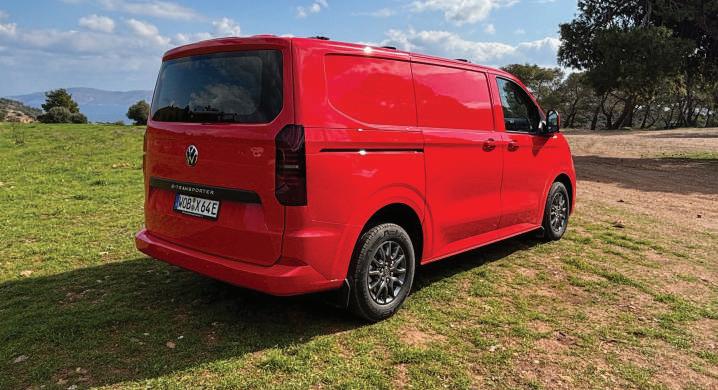
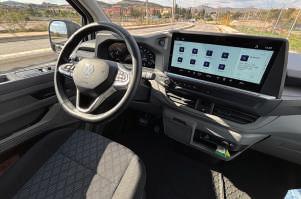

settings the regeneration is noticeable, but in fairness it’s not that intrusive and certainly not one-pedal. It will, of course, help you eke out that extra range, especially useful in the colder months.
Pros
Excellent to drive, very well equipped and hugely practical – a total payload of between 1,013kg and 1,088kg is much higher than the Buzz Cargo’s 592kg, for example. It’s also cheaper than the Electric Transit Custom, and comes with a better warranty.
Cons
Payload is less than the diesel version. It’s also more expensive. Real world range likely to be 150 motorway miles, or 170 urban miles. It is very similar to the Ford Transit E-Custom.
Utilising the engine platform from the Ford Transit Custom, Volkswagen has produced a much better, more practical electric panel van than before. Class leading in almost every area with plenty of Volkswagen traits, including the front end and grille, as well as VW’s interior set-up, infotainment and digital driver’s cluster. Seat finishes and plastics feel nicer than those in the Ford. Compared with the ‘other’ mid-sized electric panel vans, namely from Stellantis, Toyota, Renault, Nissan and Maxus, the electric Transporter is competitive from a practical and range perspective and as with the Custom, has a classier, more durable cabin. Comfortably ahead of the MercedesBenz e-Vito for range.
A German-American alliance.
CC&V RATING: N N N N

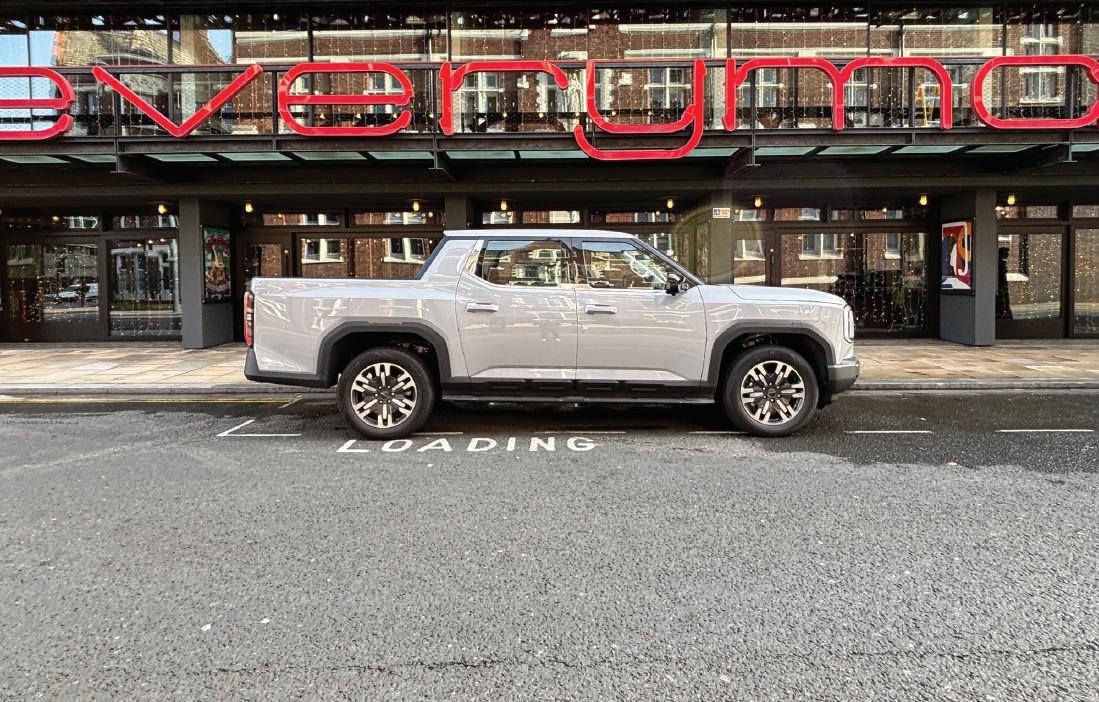

IT’S ONLY been two years since Maxus launched its first electric pick-up, the T90. It has been and gone, though, to be replaced in double-quick time by a new model, the eTERRON 9. Andrew Walker spent an enjoyable morning in Liverpool putting one to the test.
What is it?
It’s the second electric pick-up from Maxus, replacing the T90 EV. Two versions are offered. The Luxury is priced from £53,000 while the Premium costs from £56,000.
It may be an electric pick-up, meaning there’s a heavy battery fitted underneath the cab and load floor, but this doesn’t prevent it offering a 620kg payload and towing up to 3,500kg braked or 750kg unbraked. Looking at its length, width, height and load bed dimensions, they mirror a standard diesel pick-up, so it’s competitive.
Electric range and battery
The eTERRON 9 comes with a 265-mile range. This is courtesy of a 102.2kWh battery which produces 325kW of maximum power. The dual-motor set-up features an 170hp e-motor at the front and 272hp system at the rear axle, generating total output of 442hp.
Off road capability and performance
The eT9 is 4WD and features an All-Terrain System. Options include Normal, Mud, Tow and Sand. Customers can also configure steering, engine power and stability to their
personal preferences. It’s performance can best be described as brisk, as the 0-62mph takes just five seconds. Top speed is 118mph.
The front features a massive Maxus logo across the front grille. There are vertical side LED light intakes while the rear load bed area is very similar to what you would find on most pick-ups. The tailgate is heavy and Maxus has included an automatic unlocking and push-power close to shut it, which is great. The bonnet can also be opened and closed this way.
There’s a large Maxus logo right across the rear, a high-mounted stop light and a step in the bumper to allow for easier access. You also get a slim light that runs across the width of the tailgate, finished off with two vertical light clusters on each corner. The sides feature black steps and a chrome low door protector. Front and rear bumpers are chunky and black. It looks more like a North American truck than a European pick-up.
At CC&V we’ve watched the growth of Maxus over the past few years with interest, and it’s the inside of the eT9 that illustrates just how far the company has come in such a short time. In effect, you’re sitting in a premium car cabin, with both the dashboard top, front and centre binnacle hewn from stone.
The highlight inside is a massive dual screen consisting of a 12.3” cluster and 12.3” central touch screen that stretches across the dashboard top. It reminded me of the
set-up in the latest Hyundai Santa Fe.
There’s no gear lever; instead, you’re presented with a right side steering wheel stalk with a simple Reverse, Neutral, Park or Drive option. The steering wheel also features switches for cruise control on the left, and on the right they work the infotainment, hands-free phone, voice control and heated steering wheel.
Located between the front seats is a massive armrest-cum-wireless phone charger where the 4x4 switch is located. Here you can connect your Smartphone via Apple CarPlay, utilising the wireless charging pad. Or plug in via the two front and two rear Type-A or Type-C USB inputs. Separate climate controls are located underneath the screen with slim air vents above.
Look up and you’ll notice that the rear view mirror offers a streaming image via a rear external camera. With the typical limited view from a pick-up’s rear window, this is another big tick for the eT9.
Cabin practicality
There are 20 cabin storage spaces, including large door pockets, a glove box and space beneath the centre armrest. eTERRON 9 comes with vehicle-to-load (V2L) functionality as standard. There are 2.2kW sockets in the front trunk and on the pick-up bed, plus an external 6.6kW connection. This means you can connect power tools easily, where extension cables won’t go. Both versions also come with a plastic bed liner, cargo slide rail, two cargo lights and rear trailer tow Interface with controller.
Continued on page 42
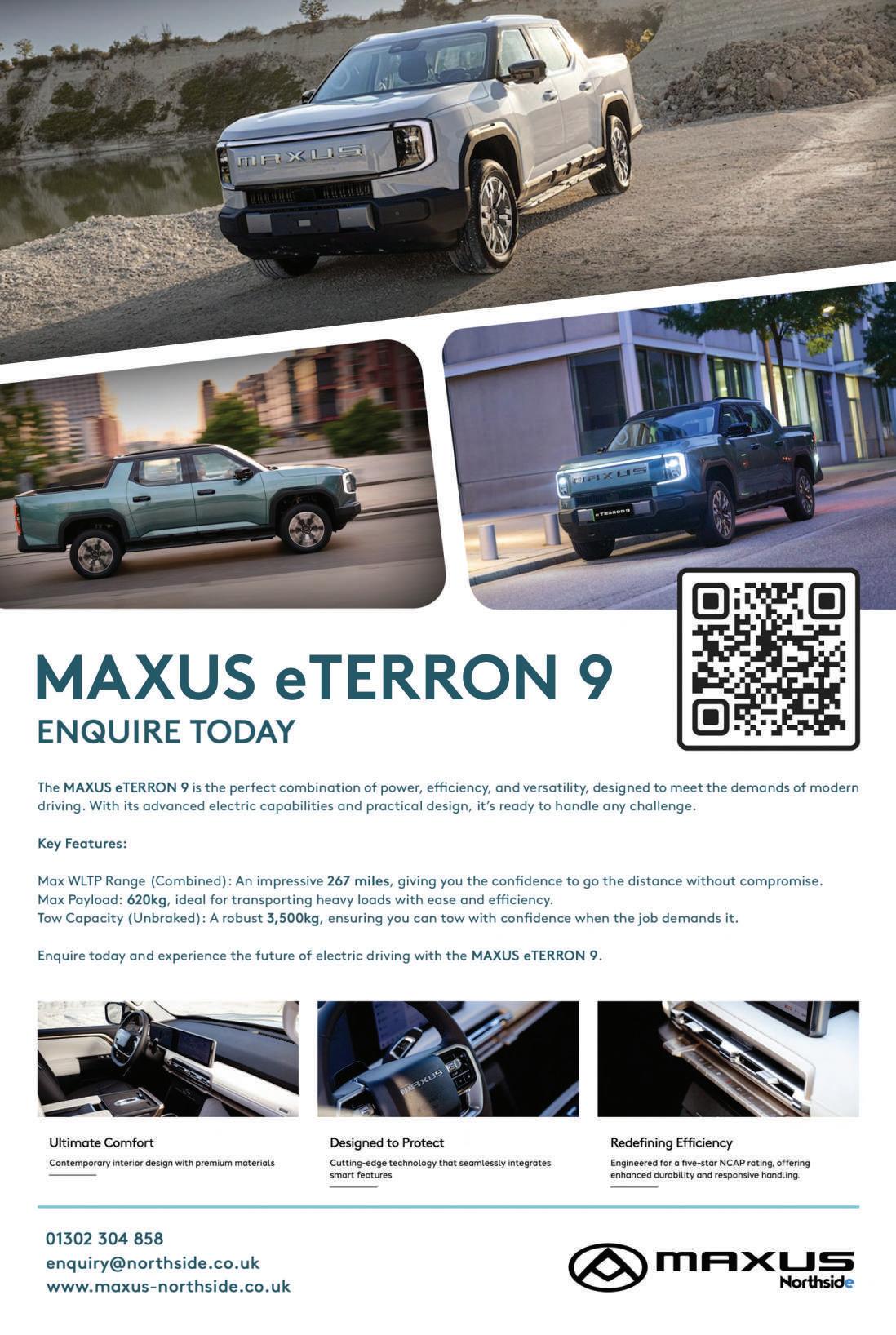
“On our drive around Liverpool city centre we were impressed. While the eT9 is quite long and wide, it never feels big, thanks to the light power steering.”
Continued from page 40
The front seats are electrically adjustable, with even a massage function on top-spec Premium. Luxury gets PVC seats, Premium models, leather.The driver and passenger are cocooned between the centre binnacle with loads of head and legroom and space in the rear is really good, so three adults should find it comfortable. Rear air con is also offered and the charging cable bag can be stored behind the rear seats or in the front trunk if preferred.
Both versions come with the latest safety features. These include a 360 degree camera, front/rear parking sensors, Adaptive Cruise Control, Forward Collision Warning, Automatic Emergency Braking, Lane Keep Assist, Lane Departure Warning, Emergency Lane Keeping, Speed Limit information, Rear Cross Traffic Alert, Rear Collision Warning, Intelligent Speed Limit Assist, Intelligent High Beam control and driver and front passenger airbags, side airbags and front to rear curtain airbags.
The eTERRON 9’s large battery gives it an excellent range. The caveat, though, is that it will take longer to charge, approximately 12 hours from 5-100% on a 7kWh home charger with 11kW capacity fitted to both versions. That time suggests a DC charger capable of 115kW speeds is a better bet, as then a 20-80% charge will take only 45 minutes.
As usual, our advice is to get a home charger, plug-in overnight when electricity is cheaper and get some faster chargers at your workplace, too. It’s a sound investment, especially with companies such as Rolec now offering 30kWh charging solutions. More details at https://www.rolecserv.com/ ev-products/ultracharge-30
We drove the eTERRON 9 on the motorway and around Liverpool city centre. Apart from the electric whine when you first accelerate, it’s very quiet, eerily so when compared to a standard diesel pick-up.
Up front the ride is quite firm. We had no one sat in the rear but we’d guess that the heavy battery underneath the cabin floor will curb every pick-up’s biggest flaw, that they are a bit bouncy for rear passengers when unladen. The battery weight should deaden this nicely, which is one of the reasons why we reckon it’s very difficult to complain about anything that the ET9 does on road. The cabin
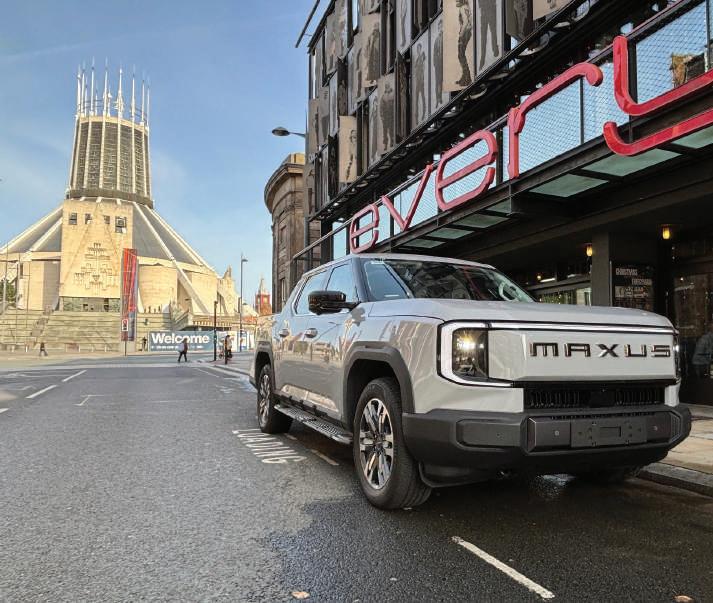
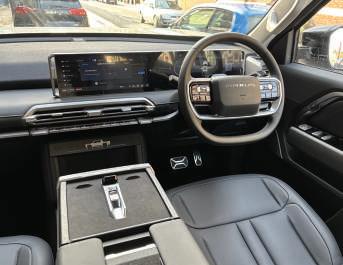
is quiet and comfortable, the dashboard and switches are easy to use and understand, and overall it’s a well-mannered ride.
The screen itself is clear and bright. Our only complaint is that the menus for driving styles, connection and the sound system are on the left, which is a bit of a reach for the driver.
The infotainment connections for Apple CarPlay were a little temperamental as you need to set yourself up on the system first, which we didn’t have time to do. Otherwise using the DAB radio was fine and the inclusion of eight speakers on our Premium model was another nice surprise.
On our drive around Liverpool city centre we were impressed. Despite being long and wide it never feels big, thanks to the light power steering. And with the standard driving modes of Eco, Normal and Sport, you’re never short of instant power to nip in and out of urban traffic.
On the motorway the eT9 cruises like a large saloon and over decent tarmac feels composed, even relaxing. As with pretty much all EVs, the vehicle weight shows itself on poor road surfaces, hardly surprising with
a CVW of 2,880kg. But it does not spoil the ride, and the eTERRON 9 feels more like a premium EV car than a diesel pick-up.
Pros
Currently the only 4WD electric pick-up you can buy in the UK. That’s a huge pro! Decent payload and load-bed area. Electric range and charging speeds are impressive. Very well equipped, quiet and surprisingly comfortable. Build quality is exceptional.
Cons
We’ve yet to take it off-road and perhaps the motor-battery combo may affect ground clearance and useability. Payload of 620kg is compromised by battery weight. At £53,000 + VAT it’s not cheap.
Maxus won the race to get an electric pickup to market with the T90 – but it wasn’t 4WD.The new eTERRON puts that right, and then some. It’s frankly miles better, illustrating just how far Maxus has come in a short time. The 620kg payload may put some off but not, we think, all, with plenty not requiring a 1,000kg carrying capacity. The key has to be a lack of competition; no-one else will get an electric pick-up to the UK until 2026 at the earliest, so Maxus can make hay while the sun shines.
CC&V RATING: N N N N N


STARTING in Wantage, Oxforshire in 1932 and now headquartered in Grove, Oxfordshire, M M Bellinger & Sons Ltd is a pillar of the local automotive landscape.
A family-run dealership, it has cultivated deep roots in the community, offering sales, servicing and parts under one roof.
The Grove-based team is renowned for its “knowledgeable, friendly” service ethos, hosting a range of new and demo vehicles, supported by a certified workshop and parts hub.
Originally focused on cars and light commercial vehicles, Bellinger has evolved over the decades to embrace niche and specialist markets, such as performance upgrades and truck transformations. This diversification underlines a forward-looking strategy that marries traditional dealer offerings with bespoke, off-roadperformance services.
A strategic partnership with Isuzu In mid-2019, Bellinger joined Isuzu UK’s expanding franchise network alongside six other new partners, elevating the number of UK Isuzu dealerships to 105. Isuzu UK’s leadership praised Bellinger’s customercentric approach, seeing it as instrumental in promoting the multi-award-winning D Max.
More recently, Bellinger was selected as a specialist Arctic Trucks dealer—equipped to handle the elite Isuzu D Max Arctic Trucks AT35 variant. This premium 35” tyred monster is fully certified for commercial use, without sacrificing payload or warranty. The appointment highlights Bellinger’s elevated technical capability and deep product knowledge.
The new Isuzu D Max: Robust, safe and award winning


The latest Isuzu DMax enters the UK market with impressive credentials: 3.5 tonne towing capacity, over 1.1 tonne payload, and a substantial five-year/125,000-mile warranty. In 2025 it clinched awards for ‘Pick-Up of the Year’ from Company Car & Van and ‘Best Range’ from the Overlander 4×4 magazine, alongside a top-tier five-star Euro NCAP safety rating.
The new range encompasses multiple trims, from the utilitarian DL20 and DL40 to the upscale V Cross, plus the bespoke Arctic Trucks AT35. Equipped for demanding offroad adventures and commercial workloads alike, the D Max offers strong diesel efficiency, full-time 4WD, and specialist accessory packages tailored to rural and workoriented customers.
What this means for buyers
For UK buyers — especially around Oxfordshire — Bellinger offers more than just


The Grovebased team is renowned for its ‘knowledgeable, friendly’ service ethos
sales. Test drives, bespoke builds (eg, the Arctic Trucks AT35), servicing, and fully stocked parts are all locally accessible. Their endorsement as specialist Arctic Trucks dealers and its emphasis on a tailored customer journey reinforce their appeal to both workhorse users (tradespeople, farmers, fleet operators) and adventurers seeking capability and durability.
In summary
With over eight decades of experience, M M Bellinger & Sons Ltd anchors its community presence in Grove while offering cutting-edge Isuzu products. The new Isuzu DMax lineup — especially the Arctic Trucks AT3 5— combines commercial practicality, offroad prowess, and awardwinning safety.
Backed by Bellinger’s dedicated local support and bespoke services, it’s a compelling proposition for anyone seeking a rugged, reliable pick-up in the UK today.
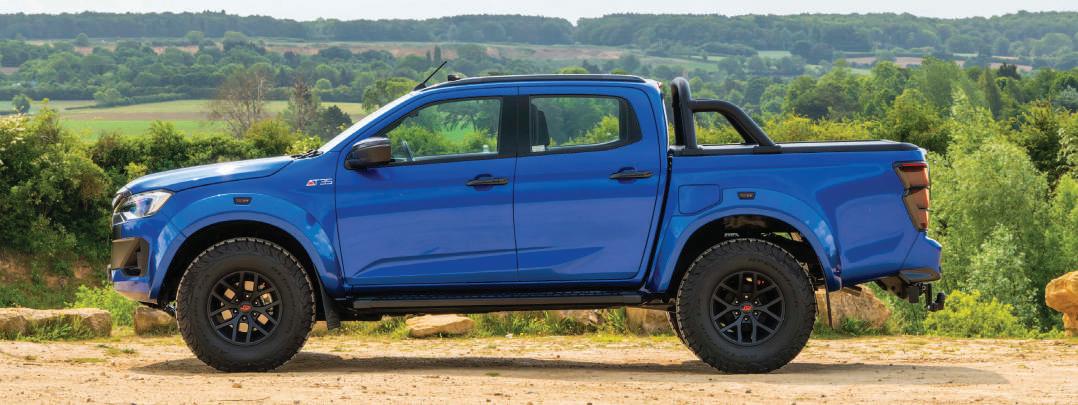

IN 2021 the Isuzu D-Max had a major update, making it at the time the safest pick-up on the road. Interior tweaks were also on the agenda, as was the addition of a ladder chassis.
But as competitors launched their new pick-ups the updates needed an update, so we popped down to a wet airfield near Leicester to take a look at the revised 2025 model range. Here’s how we got on.
What’s new?
There’s a new bonnet, radiator grille, tail lights and bumper design. A re-designed tailgate and an upgraded ADAS system with a wider viewing angle also feature.
Infotainment and tech
D-Max tech has been upgraded. You now get wireless smartphone mirroring on every model with part-digital instruments on the V-Cross. A new Rough Terrain mode on the electronic traction control offers extra help on slippery surfaces or steep inclines.
In more detail
Right across the range the D-Max infotainment systems been upgraded. So

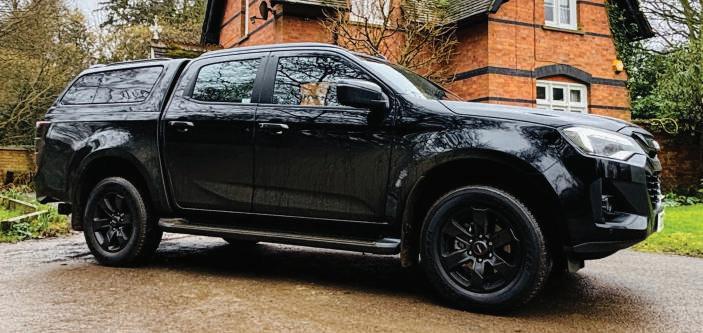
Utility and DL20 get an 8.0” screen, DL40 and V-Cross models a 9.0” version with wireless device charging. The system is more logical too, with DAB, AM and FM radio all located in the same place.
Model range
The D-Max comes in two ranges –Business and All-Purpose – with four trim levels: Utility, DL20, DL40 and V-Cross.

There’s also the Arctic Trucks AT35. We drove the V-Cross; it is leading the way in pick-up sales but may suffer when the new BIK double-cab rules hit in April. Better news is that the Single and Extended Cab bodies won’t be subject to the BIK change coming in April as they’ll still qualify as commercial vehicles.
Note that single cab models sit 20mm lower than extended or double cabs so aren’t as adept off-road. Continued on pg 46

Continued from page 45
Prices
The single cab Isuzu D-Max Utility starts from around £27,500, while the V-Cross double-cab starts at £38,000.
Engine and chassis
The 1.9-litre 162bhp engine has been carried over from the previous model. The ladder frame chassis has made it stronger while the longer wheelbase increases load and cabin space.
With 360Nm torque there’s ample power for most, but the very short first gear means you need to change up quickly. The auto box is better but you need to adjust accordingly when pulling out of a junction.
Every version has a payload rating of at least 1,070kg – vital for tax.There’s also a 3.5 tonnes towing capacity. As every variant weights under 2,040kg it is subject to normal passenger car speed limits, unlike may rivals that go over the threshold and so have to stick to a lower speed limit.
Will it get me through the tough stuff?
The D-Max is still perfect for anyone who needs to use their truck off-road. All versions offer selectable shift-on-the-fly 4WD drive, and on all models bar entry-level Utility, the mechanical rear diff lock gives the D-Max plenty of ability.
The new Rough Terrain function, plus hill

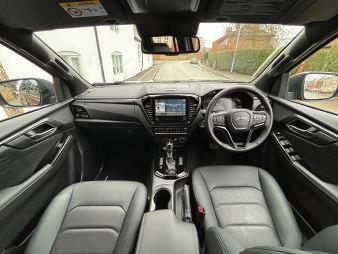
descent control and hill start assist also help with off-roading, and you also get a wading depth of 800mm. What’s it like to drive
So much better to drive than the old model and now proper competition for the Ford Ranger, Toyota Hilux and VW Amarok . It handles the road much more like a large SUV than a pick-up. It’s easy to drive and manoeuvre and also features excellent brakes. The latest seats are comfortable and coupled with the improved body structure, there’s far less body-roll than on previous incarnations.
On the motorway the V-Cross will cruise along happily at motorway speeds. In town it’s surprisingly agile and thanks to the reverse parking camera, easy to park as well. Possibly not as smooth as the larger engines found on competitors, and it doesn’t have their torque either.
None the less, by far the best Isuzu pick-up
yet and a CC&V favourite based on price, availability, model choice, conversion options and a family-friendly dealer network.
Emissions and fuel economy
V-Cross manual offers 33.6 mpg/auto 30.7 mpg with emissions of 220g/km and 241g/ km respectively. Move up to a high-spec model with an automatic gearbox and that drops to 31.4mpg and 235g/km of CO2.
Pros
Excellent model choice and loads of conversion options. The latest upgrades only add to the D-Max’s appeal.
Cons
The 1.9 engine works fine in almost every situation, but it’s lack of out and out pull could be an issue for some. There’s still some cheaper plastics. Rear seat passengers should expect the occasional bumpy ride when the loadspace is empty.
Isuzu remains committed to the pick-up sector, for which it should be applauded, and the range of options means there is a D-Max for everyone. Latest upgrades boost refinement and drive, and it looks better than before. A contender for those who want a lifestyle pick-up.
CC&V RATING: N N N N

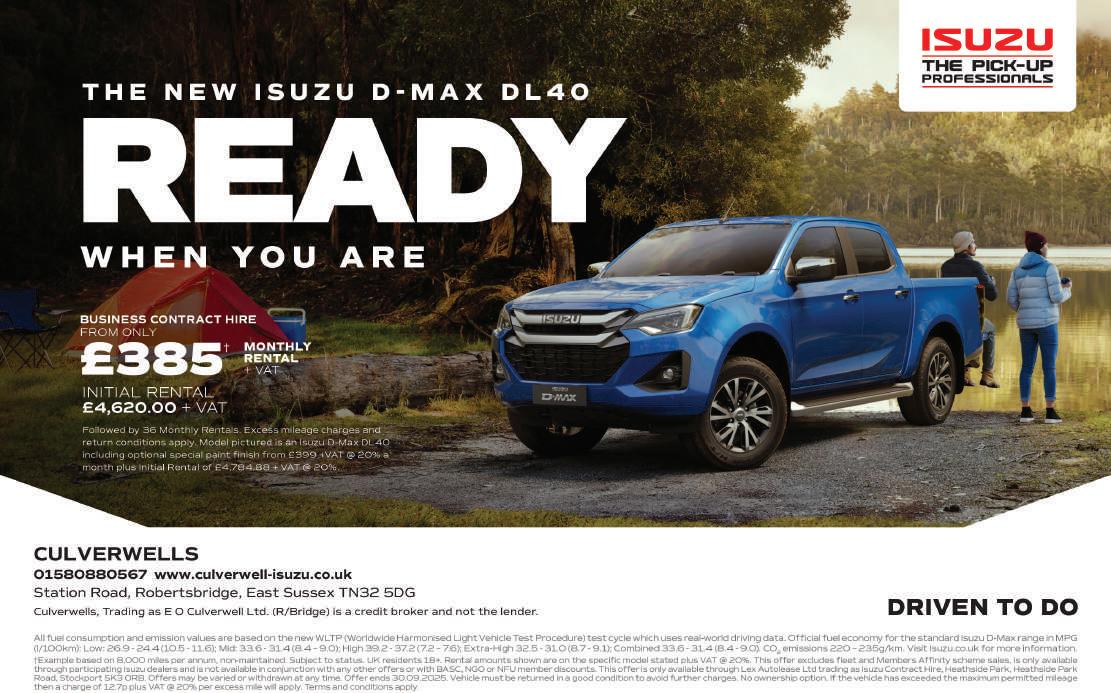
Mercedes has massively improved the battery range of its Vito, making it a far more attractive option in what is a fast-growing sector. CC&V got to grips with one recently: here’s how we got on


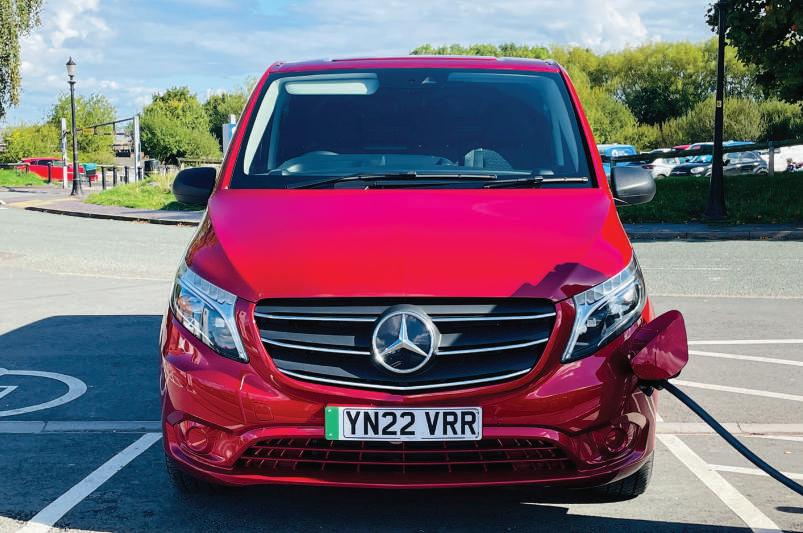

The eVito: What is it?
THE electric eVito looks and feels just the same as a diesel Vito, except that it’s powered by an 114bhp 85kW electric motor offering 300Nm of torque. It now features a 66kWh battery with a WLTP range of 162 miles, well up from the 93 miles of its predecessor.
Charging
AC charging to 11kW and DC to 80kW are both standard on eVito. As ever, plug-in at home or at work for cheaper rates, we use Rolec chargers, https://www.rolecserv. com/ev-charging
Model range and sizes
We were testing the PREMIUM specced eVito which cost from £46,900, with a cheaper PROGESSIVE also offered. The eVito is offered in two lengths, L2 or L3. As far as storage goes, the L2 model offers 6m3 cargo volume, 2,451 kg kerb weight, 3,200 kg GVW, with a payload of 824 kg. The L3 offers 6.6 m3 cargo volume, 2,302 kg kerb weight, 3,200 kg GVW and a payload of 898 kg.
Specs and safety
eVito PROGRESSIVE offers colour coded bumpers, full wheel covers, front fog lights, Headlight Assist, a 75mph speed limiter, Audio 30, lumbar support and electrically foldable mirrors. PREMIUM includes Hyacinth red metallic paint and a spare wheel with jack as no cost options. It also features a leather
steering wheel, PARKTRONIC, reversing camera, hate insulting glass, TEMPMATIC semi auto air-con and cruise control. Mercedes PRO connect, comes as standard and it’s free for the first three years. Benefits for driver and fleet manager, include Remote Access, Digital Drivers’ Log, Drive Style monitoring, real-time variable servicing monitoring, parking time monitor and geo-fence options. As an electric van, the eVito benefits from pre-conditioning of the heaters and highlights the vehicle charging options nearby.
From the outside it looks just like standard Vito and you’d be hard pressed to know it’s an electric van unless you get up close and read the discreet eVito and eLECTRIC badging. The fuel cap is now located in the front left hand side of the van.
You get the updated Vito interior, which
“The quality of the cabin puts rivals to shame... it really has all the hallmarks you would expect from a Mercedes-Benz ...”
includes two USBs and a heated front driver seat. There’s a three-seat configuration up front, as well as some top of the dash storage, a decent glove box and two handy deep door pockets, but not anywhere to fit a large bottle or drinks container.
The ignition is on the left of the usual steering column, while the gear lever is mounted on the right meaning the headlight and wipers are both on the right stalk. Cue changing into neutral a lot when it rains.
Power steering is standard and the wheel is both rake and reach adjustable. The driver’s seat also offers a myriad of adjustment, so getting comfortable was not a problem. The handbrake is located on the floor as it is in Mercedes cars. You push a ‘fourth’ pedal with your left foot to engage the brake and then pull a dash mounted lever to release. I found it straightforward to use, although some may not like it as it doesn’t help you with hill starts.
In the centre of the dash and higher up than in some vans are the Audio 30 infotainment system and heating controls. The infotainment screen is slightly awkward to reach for the driver, as is the USB input which is on the left of the dash. For a left-hand driven Vito, this location would make perfect sense. The front windows are electric and keeping the cabin quiet is a full width bulkhead. The quality is top-notch but it’s not as practical a cab as some competitors.
Continued on page 48


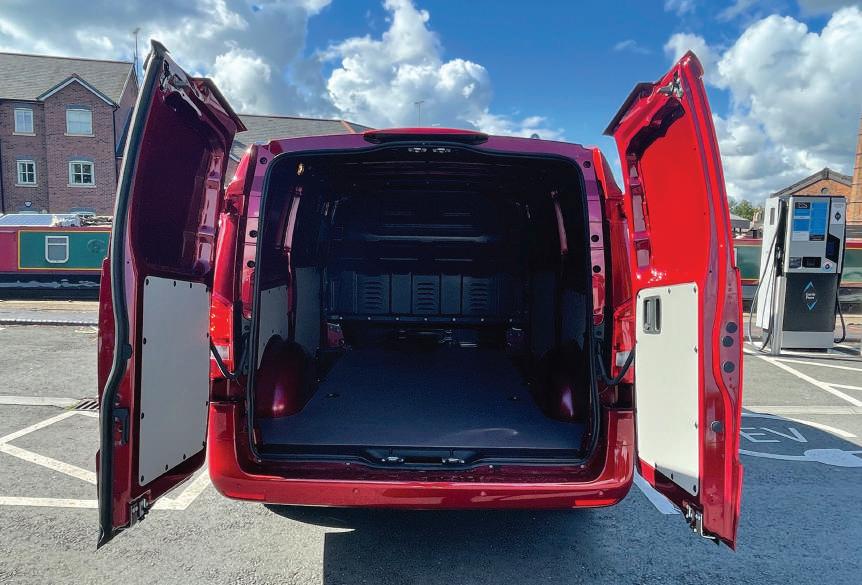
Continued from page 47
The rear load space is easily accessed as the L2 Vito we drove comes with left and right hand slide-opening side doors and twin rear doors that open 180 degrees. To be fair we used it only once, to transport a mountain bike into the Peak District and it was a simple enough task to fix the bike to the hooks located in the rear floorspace, to stop it moving around.
Of more interest I’m sure, is how the eVito drives and how far one can travel in it. For starters it’s easy to drive and very relaxing on the motorway.
The gear lever offers Neutral, Reverse or Drive options and even with the battery weight underneath the floor, the eVito handles pretty well for it’s weight.
As with most electric cars, the eVito offers several levels of regenerative braking, which can be adjusted using the paddles on either side of the steering wheel. This enables you in traffic or in town, to utilise D-, the strongest regenerative level, which is also the most noticeable. You can then decrease the strength of regeneration by pulling on the right hand paddle, moving through the options of D, then D+ and as we found for motorway driving the very useful D++.
When driving the eVito, you can choose from three drive modes; E+, E or C. There is a button on the centre console dash to select these. E+ offers the most efficient driving style; E is the middle option and the one we preferred or you can select C, which is the least efficient, or the most fun.

“Using the regenerative braking allows you to keep the battery topped up as you drive, and eVito delivers that 140+ mile range”
The eVito was delivered with a full charge offering a 157-mile range. We drove the eVito to Chester in drive mode E along the M56 at around 70mph, a total distance of 30 miles. On arrival at Tesco, we took advantage of its Podpoint charger while we shopped in the store. Our journey had decreased the range from 157 miles to 118 and after an hour charging was up to 126 miles for the return leg. Thirty miles later and back home, the range now showed 98 miles.
We then repeated the identical journey the following day and we concluded that if driven unladen with just a driver, at mostly motorway speeds, then the eVito offers a 140-mile range.
For the remainder of our week we drove locally and at lower speeds of up to 50mph. At these speeds as we found, the range increased to 157 miles, as you can really take advantage of the regenerative braking to keep that battery topped up.
In comparison to other similar sized electric vans, such as the Vivaro-e, e-Dispatch, e-Scudo and e-Expert, range of the eVito can now match or even surpass, the Stellantis claimed WLTP battery range of 143 miles.
Much improved battery range now gives the eVito a competitive range. The cabin is hewn from granite, top quality and very comfortable. The addition of proper air-con is also an improvement. The overall build quality puts the competition to shame.
The infotainment system isn’t as good as you’ll find on some other vans. Similarly, neither is the payload.
The improved range of the eVito made longer journeys in it a lot let less stressful. It performed well above average on our EV mileage range tests, it’s comfortable, quiet to drive and offers Apple CarPlay or Android Auto, something we really can’t live without.
You may be reading this and thinking that the 150-160 mile eVito range that we experienced, is nowhere near enough, but we reckon that plenty of businesses, don’t need a complete fleet of long-distance diesel vans.
Ultimately, we think it will come down to the buyers confidence in the eVito’s range, their daily mileage, plus their access to charging points. If your business has charging stations, or you have one at home, there really is nothing to fear from an electric Vito.
CC&V RATING: N N N N

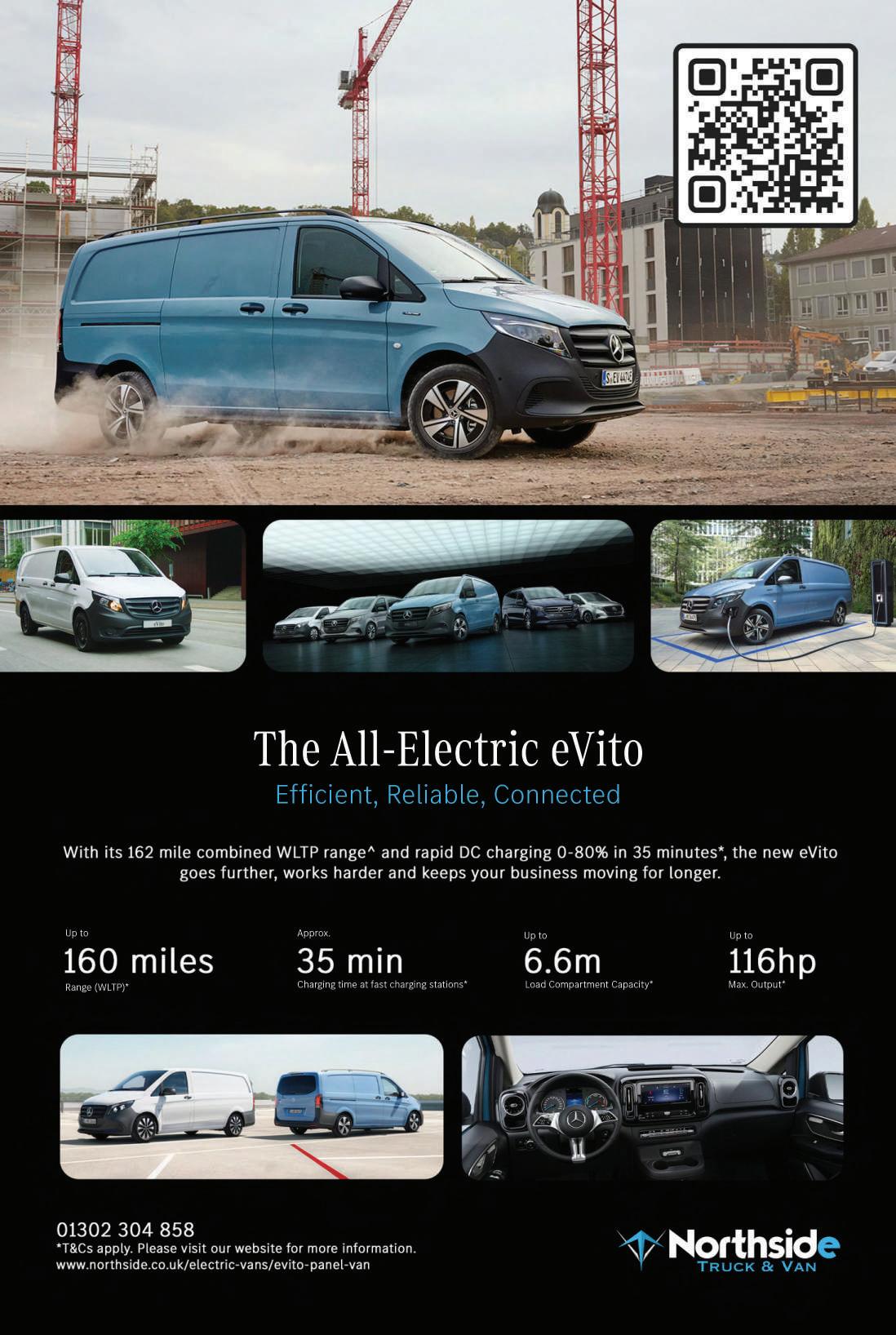
THE Nissan Interstar boasts class-leading aerodynamics and enhanced load-carrying capacity to create a CV offer that is leading the way when it comes to practicality.
Available with a 100% electric powertrain and up to 285 miles of driving range, it offers multiple adaptations to meet the needs of any business, keeping you powering on.
Upgraded standard safety features ensure top-tier protection, earning the Platinum rating in the EURO NCAP safety test, while enhanced cabin comfort provides a stressfree driving experience.
All-in-all it’s built to deliver everything you’d expect from a world-class large van while complying with urban policies on pollution and air quality. The Interstar is perfectly tailored for city-based customers looking to jump seamlessly from one job to the other, with a model that’s efficient, reliable, and won’t let them down.
Like all Nissan vans, Interstar comes with a standard warranty of five years or 100,000 miles. Should you choose an Interstar-e, the warranty for EV battery is increased to 8 years.
An all-electric landmark for the modern era
The new Nissan Interstar is making history as Nissan’s first-ever fully-electric large van, with a diesel version also in production.
As Nissan heads towards electrifying all segments within its LCV line-up by 2027, the launch marks a major milestone on our journey. The 100% electric powertrain model offers a 40kWh battery, ideal for urban delivery usage, and a long-range 87kWh option for wider applications. With a maximum DC charging speed of 130kW for the 87kWh battery, it delivers up to 157 miles of range in just 30 minutes.
Also available with a standard 22kW AC charger for the 87kWh battery, or a standard 11kW AC charger for 40kWh battery, the all-new Interstar-e is designed for depot use, charging from 10% to 100% in less than 4 hours. The new van can be chosen without compromise, offering a 4.0T version that supports over 1.5 tonnes of payload.
To meet the diverse needs of van buyers, Interstar is also available with a range of efficient diesel engines. Powered by the 2.0-litre engine already used in other Nissan models, this new application for the Interstar delivers up to 170PS and 380Nm. The upgraded diesel motor delivers an average reduction in fuel consumption of 1.5ltr/100km, with overall consumption as low as 7.4ltr/100km, allowing customers to travel for longer while making potentially costly refuelling stops less regular.
Customers can choose between a six-speed manual or the new, refined and efficient nine-speed automatic transmission,


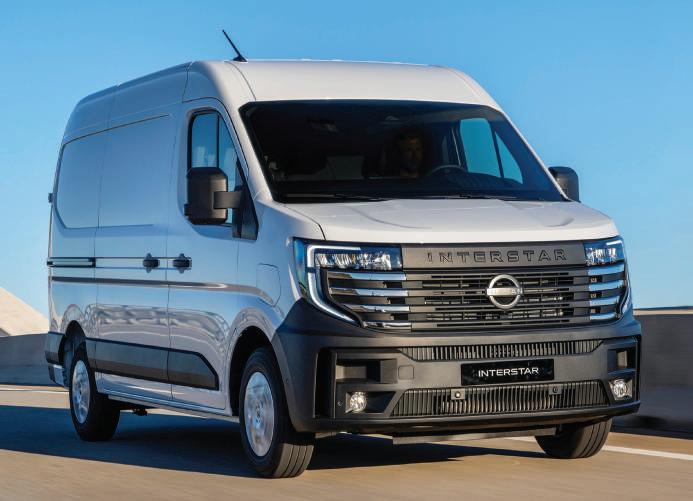
providing flexibility and control for different driving preferences.
Strength and versatility for all your business needs
Building on the legacy of an already popular van choice, it’s the model’s spaciousness and versatility that really set it apart from its predecessors. Armed with a longer load area of up to 3,855mm depending on wheelbase and a class leading 1,312mmwide side door, the latest Interstar ensures that fitting in cargo has never been easier. Moreover, if it is sufficient cargo space you are after, the all-new Interstar is for you, with a capacity that varies from 10.8m3 in the L2H2 version to a maximum of 14.8m3 in the L3H3 version. With the model’s max towing capacity of 2,500kg, customers can take on even greater loads in order to meet the myriad needs of their day-to-day lives.
If that’s not enough, the model boasts serious payload competitiveness of 4T up to 1.9 tonnes for the ICE version of the van and 4T up to 1.6 tonnes for the EV version.
Comfort front of mind
The Interstar also displays an improved manoeuvrability, with a turning diameter reduced by 1.2m (depending on version) compared to earlier models. This makes handling tight urban streets noticeably smoother, without compromising the van’s load-carrying capacity.
At the same time, Interstar ramps up the user experience on the interior thanks to a completely redesigned, spacious, and modern cockpit, delivering comfort, convenience, and a welcoming environment to drivers and passengers alike. An additional

135ltrs (depending on version) of storage space in the cabin is another boon for the driver, as are the presence of new tech such a Apple CarPlay and Android Auto.
The wider and highly versatile interior allows for a host of workspace possibilities no matter the industry. Looking to turn your van into a portable office? The all-new Interstar is the solution, all done in comfort and style.
Safety and security for all inside
Interstar drivers are given added peace of mind as our latest model is equipped with the newest safety additions featured in Nissan models. Through our Forward Emergency Braking and Electronic Stability Programme, Lane Keep Assist or Traffic Sign Recognition, and a host of other safety additions never seen before on a previous Interstar model, you can hit the road in your next generation Interstar, safe in the knowledge that your wellbeing was at the forefront of its design.
Another exciting addition to the new Interstar is the innovative one-box braking system. This electronically managed hydraulic system saves weight, improves braking power, and provides users with consistent braking no matter the payload of the van. Enhanced efficiency is also provided for EV versions through the brakes, thanks to brake energy regeneration.
Don’t just take our word for the Interstar’s safety capabilities – the latest version recently shined bright and received top marks in the EuroNCAP Safety Ratings, with an impressive ‘Platinum’ rating. This means you can go about your day-to-day with complete peace of mind that you, and your passengers, are in the safest of hands.
